Home » Europe » Montenegro » The Crown of the Balkans: How to Make the Most of your Montenegro Itinerary

The Crown of the Balkans: How to Make the Most of your Montenegro Itinerary
We may receive a commission if you make purchases through affiliate links (at no extra cost to you). Read why our approach to travel is different.
Share This Article
Date Published
Last Updated
Alex Johnson
Alex is the author of the travel books A Long Weekend in Ulaanbaatar and Running the Milk, he is currently living in rural North Yorkshire while he writes his next books
Less than 20 years ago , Montenegro did not exist. When the USSR collapsed, Montenegro became part of what was the Federal Republic of Yugoslavia, comprising what we now know as Serbia and Montenegro. It was only in 2006 that a referendum paved they way for an independent Montenegro .
Not only one of the newest countries in the world , Montenegro is also one of the smallest . Despite its size, Montenegro is bursting at the seams with breath-taking scenery, a rich cultural tapestry and a little-known, yet divine local cuisine .

From the majestic Bay of Kotor to Budva’s beautiful beaches and parties , Montenegro’s Adriatic coast is a feast for the senses . Inland, the rugged Komovi Mountains and the towering peaks of Lovcen National Park are beyond dramatic. And when you’re craving culture, historic Kotor provides an overload and is an absolute must on your Montenegro itinerary.
Through Croatia
Podgorica airport, tivat airport, where to stay in montenegro, public transport, perast & our lady of the rocks, lake skadar, sveti stefan, lovcen national park, herceg-novi, getting to montenegro.
A few years ago, getting to Montenegro was an adventure in itself . Few international flights served the country and packages holidays were unheard of. The journey to Montenegro more often than not entailed a flight to Dubrovnik and a long, but scenic, bus ride across the border.

It’s still possible to reach Montenegro this way: buses run five times per day between Dubrovnik and Kotor, stopping in the border town of Herceg-Novi along the way. Schedules change at short notice, so ensure you double check close to departure . This happened to me on my first visit to Montenegro. If I hadn’t checked and traveled back to Dubrovnik a day earlier, I would have missed my flight.
The good news is it’s now much easier to fly directly to Montenegro . Podgorica Airport, 11 km south of the capital, is the busiest. Ryanair flies year-round from London Stansted , and Wizz offers seasonal flights from Gatwick . A year-round service is also provided from a number of European airports, so it’s worth comparing options to see which best suits your plans and budget.

Podgorica isn’t usually top of the list on any Montenegro itinerary. At first glance, it’s a brutalist eyesore, but in reality, it’s well worth a visit , especially if you’re arriving here. The city’s architecture shows just how varied Montenegro’s past is . Podgorica has been part of the Ottoman Empire, Austro-Hungarian Empire and the USSR – and, like any good European city, has been razed to the ground twice .
Montenegro’s other airport is slightly more convenient for exploring the Bay of Kotor. Tivat Airport is right on the coast, but most airlines only fly here seasonally . Year-round routes exist to Istanbul and Belgrade, but during the summer there are dozens of services from across Europe.
From the UK , easyJet serves Tivat from Bristol , Manchester and London’s Gatwick and Luton whilst Jet2 operate from Birmingham , Manchester and Stansted.
As tourism has grown dramatically in recent years , wherever you go in Montenegro, there are plenty of places to stay and hotels to suit all budgets . Montenegro is a small country so choosing a good location to base yourself will really enhance your Montenegro itinerary.
What we mean is, you want to get it right; so we’ve written a separate guide of all of the best places to stay in Montenegro.

Getting around Montenegro
Given its small size, it’s quite easy to fit all of the country’s top sights into one Montenegro itinerary . Hiring a car is the best option for making the most of your time. Rental cars are available from Podgorica and Tivat , and there are agencies in most large towns.
To drive in Montenegro, most travelers (including Brits, Americans and Australians) will require a 1968 International Driving Permit . Make sure you get one before you leave your home country. The police carry out frequent speed checks and there are harsh penalties for breaking the speed limit even by a small amount.
Public transport in Montenegro is excellent , so don’t worry if you don’t drive or don’t fancy renting a car. There is a limited, but reliable, rail network centred on Podgorica. Trains run to Niksic and Shkoder with international services extending to Belgrade , Serbia.

James Bond fans might remember the scene in Casino Royale where Bond rides on a Montenegrin train . Sadly, you won’t be able to recreate the scene as it was actually filmed in the Czech Republic !
For most of your Montenegro itinerary, buses will be the main mode of transport. There’s an excellent network , particularly around the Bay of Kotor and to Podgorica. Timetables are often not available online , so you’ll need to check with your accommodation or at the bus station.
Always carry cash when catching a bus as cards aren’t usually accepted .
Unmissable Spots on any Montenegro Itinerary
If Montenegro is the crown of the Balkans, Kotor is the jewel in that crown . Situated on the 28 kilometer-long Bay of Kotor , the first mention of Kotor was during Roman rule in 168 BC , although its origins are thought to go back much further. Fortified in the Middle Ages , Kotor’s biggest draw is its walled old town.

The main draws of the old town ( starigrad in Montenegrin) are its beautiful cobbled streets and passageways which are really easy to get lost in (I speak from experience). Top museums include the Maritime Museum and, because cats are an essential part of Montenegrin life, the Cats Museum .
The best way to explore the old town is to take a guided walking tour . You’ll learn a lot about the city’s long history and it’ll save you getting lost. Another great experience is to join a private food and wine tasting with a local family . As much as Kotor has some truly excellent restaurants , there’s nothing quite like sampling proper homemade food just as the locals eat it.

Just a 15-minute drive from Kotor, the charming town of Perast is unmissable on any Montenegro itinerary. Famous for its crystal clear waters , Perast is one of the most beautiful places in Montenegro, if not the world.
You can join a tour from Kotor to Perast, which includes a trip to Our Lady of the Rocks, or take the bus which runs every 30 minutes. If you choose the bus, you’ll need to arrange a boat trip to Our Lady of the Rocks locally. You’ll find plenty of boatmen willing to take you across at the waterside.

A highlight of any Montenegro itinerary and one of the Bay of Kotor’s most famous sights, Our Lady of the Rocks is home to a Catholic church and shrine. It is said to have been built by local seamen in the 15th century , and since then the islet grew as they added stones for luck before heading out on a voyage. Regardless of your religious views, a visit to the church is an amazing experience .
Marking the border between Montenegro and Albania, Lake Skadar is the largest lake in Southern Europe . Its surface is 530 square kilometers which means Lake Skadar really is massive. It’s possible to drive all the way around it, but doing so involves crossing into Albania , so make sure you take your passport (and check if you need a visa before traveling).

Some of the best views can be had from Virpazar. If you stop there, be sure to pause for lunch at Konoba Starcevo , one of the best restaurants in Kotor , just before the bridge leading towards Podgorica. The food is fantastic , especially if you’re a seafood lover, but the views are even better . On the other side of the bridge, stop off at the Church of Vranina, an ancient monastery right on the water’s edge.
For a different perspective of the lake , take a guided sightseeing cruise which leave from Virpazar. Better still, you’ll have the opportunity to try local wines from Winery Masanovic onboard .
Six kilometers along the coast from Budva, Sveti Stefan is a gorgeous island connected to the mainland by a tombolo . This is the place to see the rich and famous – and not just the Montenegrin rich and famous, the world’s rich and famous. Sveti Stefan is basically the Capri of Montenegro.

Sveti Stefan’s stunning old town was built during Venetian rule in the 15th century but it sadly fell into disrepair following the breakup of Yugoslavia. In 2009, the Montenegrin government launched plans to give Sveti Stefan a new lease of life, and the result is rather unusual. They gave a contract to Aman Resorts, a luxury hotelier, to manage the entire island.
Aman Resorts opened a hotel, the Villa Milocer , and gave the island a new lease of life. It is now, once again, one of Montenegro’s top tourist destinations and an unmissable stop on your Montenegro itinerary. Whilst staying at the resort is a great, albeit rather pricey experience, the islet is open to anyone.
Home to Montenegro’s highest peak and its old capital, Lovcen National Park is beyond beautiful . Lovcen Mountain stands at 1,749 m high and is the inspiration for the country’s name which translates as “black mountain.”

A must-see at Lovcen during your Montenegro itinerary is the Mausoleum of Peter Petrovic Njegos. It was constructed in 1971 and is the final resting place of Njegos, the former Prince-Bishop of Montenegro who was born in Njegusi, near Cetinje, the ancient capital of Montenegro which is located within the park.
To reach the top, take the cable car which provides panoramic views to as far away as Kotor and Podgorica. On a clear day, you can even see Croatia and Bosnia . For the best experience, discover Lovcen with a tour of the national park which includes the chance to sample a typical Montenegrin lunch .
Sitting on the border between Montenegro and Croatia, in the shadow of the Orjen mountains, Herceg-Novi is one of the best examples of a typical Montenegrin old town . It boasts a rich history, with the town’s origins traceable to the Bronze Age before it was settled by Bosnians in the 14th century who fortified the town.

The old town’s main draws include five Serbian Orthodox Churches, narrow cobbled streets and a beautiful harbor. From here, you can take a boat trip to nearby beaches (payable locally). To learn more about the old town’s history, take a private walking tour with a local guide to see Forte Mare and Kanli Kula fortresses and Belavista Square .

Traveling soon? Subscribe to The Insight below and get exclusive access to our personalized travel advice community via WhatsApp so you can ask all your burning travel questions.
Looking for the best comprehensive travel insurance? SafetyWing has you covered. And for your eSIM in every country, there is only one option we recommend: Airalo .
Read more of our best insights from around the world

Planifier votre voyage
Vous préparez votre séjour au Monténégro et vous avez besoin d’aide? Nous vous apportons des informations et des conseils pratiques pour faciliter vos préparatifs.
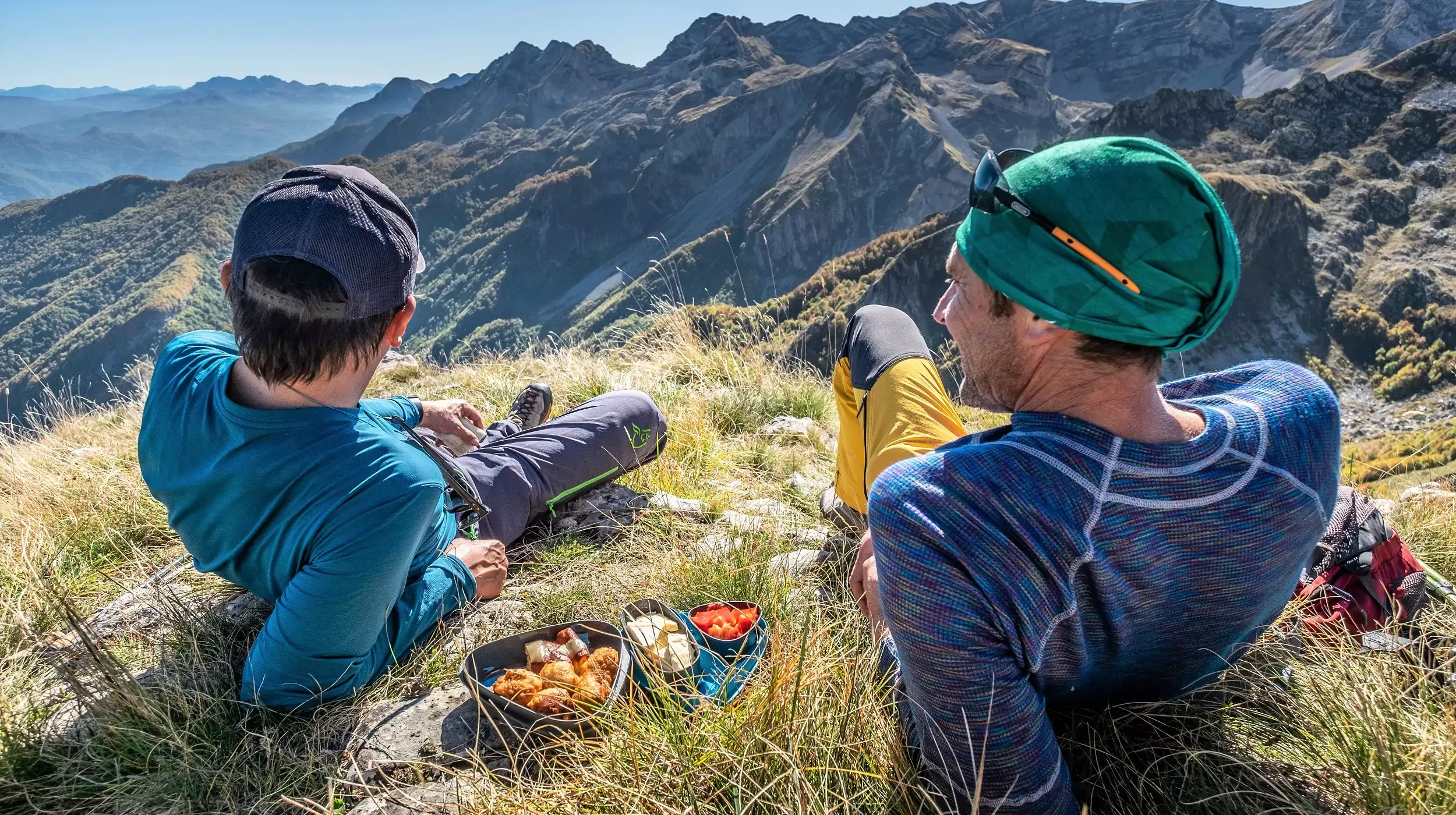
Préparez votre voyage selon vos goûts et vos envies
Que préférez-vous? Partir loin de la civilisation, au cœur de la nature, et pendant quelques jours ne pas être joignable ni par téléphone ni par mail et encore moins sur les réseaux sociaux? Ou bien commencer votre journée par un café sur la place d’une des Vieilles villes du littoral et la finir par un concert au bord de la mer ou encore profiter de l’une des nombreuses plages du littoral?
Quel que soit votre choix, le Monténégro vous offre tout ceci et bien plus encore…. Venez profiter de ce pays magnifique!
Routeperfect - Planificateur de voyage
A la recherche d'idées pour votre voyage.
Lisez les impressions des visiteurs. Nous aimerions avoir les vôtres: partagez-les avec le hashtag suivant: #MontenegroWildBeauty #GoMontenegro
Découvrez ce pays unique!
Si petit que vous pourriez en faire le tour en une après-midi. Ne le survolez pas mais essayez au contraire de vous imprégner de sa beauté et de son caractère.
Explorez cette destination toute l'année
Un petit pays d'une incroyable diversité. Voyez tout ce qu'il a à vous offrir:
Voyagez de manière responsable
"Le saviez-vous? En 1991, les autorités monténégrines ont adopté une charte faisant du Monténégro le premier Etat écologique au monde. "
Quelques conseils et recommandations
Goûts et saveurs du monténégro, patrimoine culturel protégé par l’unesco, les routes panoramiques du monténégro, politique de confidentialité.
Voici les types de cookies qui sont utilisés sur ce site. Vous pouvez accepter ou désactiver les cookies.
Accessibilité du site Web CTRL + U
Raccourcis clavier.

Voyage Monténégro - Croatie Les Citadelles de l'Adriatique
Circuit Monténégro - Croatie au volant : Les Citadelles de l'Adriatique
Sublime fil d’Ariane de ce voyage le long des côtes dalmates, le bleu pénétrant de l’Adriatique frappe aux portes d’imprenables citadelles blanches irradiées par une douce lumière dorée. Franchissez ces hautes murailles pour explorer les siècles d’Histoire incroyablement conservés de Split, Korcula et Dubrovnik et goûter à un art de vivre typiquement méditerranéen avant de rallier les Bouches de Kotor au Monténégro, ultimes remparts naturels des bords de l’Adriatique…

- Les ruelles de Dubrovnik et Split, véritables musées à ciel ouvert
- L'île de Korcula avec sa douceur insulaire et son riche patrimoine
- La découverte des saveurs méditerranéennes de la cuisine dalmate
- Le décor sublime des Bouches de Kotor au Monténégro
France Split

Envol pour les rivages millénaires de Split, capitale de la très belle région méridionale de la Dalmatie. Du haut de ses fortifications, la cité replonge le voyageur en l'an 300, sous le règne fastueux de Dioclétien. L'Empereur romain laissa un palais, véritable ville dans la ville, dont les vestiges sont inscrits à l'Unesco. Transfert à vôtre hôtel.

Une formidable ambiance de village habite le front de mer, le grand marché et les ruelles joliment pavées de pierre blanche de Brac. Maintes civilisations y laissèrent l'empreinte de leur passage composant un étonnant mariage d'héritages : plus ancienne cathédrale romaine du monde, grandes places inspirées de l’architecture vénitienne…
Split / Ile de Korcula

Des restaurants familiaux servant la pêche du jour, des criques secrètes où se baigner, des pieds de vignes et d'oliviers composant l'arrière-pays le plus boisé de Croatie... Tous les ingrédients de la douceur de vivre méditerranéenne sont réunis sur la charmante île de Korcula, lieu de naissance supposé de Marco Polo. Remise de votre véhicule de location et ferry pour Korcula.
Ile de Korcula

Outre sa nature authentique, l'île de Korcula est réputée pour son bourg médiéval, lui aussi porteur de l’illustre sceau vénitien. Empruntez un bel escalier du 19ème siècle pour entrer dans sa Vieille Ville ceinte d'éminentes tours blanches et en découvrir la grande tour Revelin, la Cathédrale St Marc et les autres monuments préservés de l'île.
Ile de Korcula / Dubrovnik

Route et ferry pour Dubrovnik, rayonnante cité inscrite à l’Unesco. Les célèbres remparts de la Perle de l’Adriatique sont désormais accessibles pour une balade aux vues panoramiques sur les toits orangés de la ville et le bleu envoutant de l’Adriatique.

Il est délicieusement facile de perdre ses repères dans les ruelles étroites et fleuries de Dubrovnik mais qu'importe que vous tourniez à gauche plutôt qu'à droite ou l'inverse tant chaque recoin de la ville renferme de trésors : l'artère centrale du Stradun, la fontaine d'Onofrio, le palais du Recteur ou le palais Sponza pour ne citer qu'eux...
Dubrovnik / Bouches de Kotor

Quittez la Croatie pour le Monténégro où se situent les spectaculaires paysages des Bouches de Kotor. Ce site naturel, inscrit à l'Unesco, est le plus grand fjord méridional d'Europe. Sinuant entre ses flancs sauvages, ses villages reculés et les eaux toutes en nuances de l'Adriatique, la beauté de la route côtière apporte un profond sentiment de quiétude.
Bouches de Kotor

Profitez de cette seconde journée aux Bouches de Kotor pour explorer ses méandres et apprécier sa nature éblouissante. Quelques bateaux assurent la navette vers les îlots flottant au milieu de cet ancien canyon submergé. Certains de ces minuscules morceaux de terre abritent d'importants témoignages artistiques : fresques baroques, sculptures...
Bouches de Kotor / Dubrovnik

Retour vers Dubrovnik.
Dubrovnik France
Restitution de votre véhicule et envol pour la France.

nos prix comprennent
- Le transport aérien international Paris / Split à l'aller et Dubrovnik / Paris au retour sur vols Lufthansa en classe économique
- L'assistance aérienne Amplitudes 24h/24 en cas d'urgences
- 09 nuits en chambre double en hôtels de catégorie supérieure, taxes hôtelières incluses
- 2 nuits à Split, en chambre double et petits déjeuners inclus
- 2 nuits à Ile de Korcula, en chambre double et petits déjeuners inclus
- 2 nuits à Dubrovnik, en chambre double et petits déjeuners inclus
- 2 nuits à Bouche de Kotor, en chambre double et petits déjeuners inclus
- 1 nuit à Dubrovnik, en chambre double et petits déjeuners inclus
- Le transfert aéroport / hôtel le jour de l'arrivée
- La location d'un véhicule Economique pour 8 jours, assurance CDW
- Les traversées en ferry Split/Korcula et Korcula/Dubrovnik
- L'assurance assistance voyages Mutuaide
- Les taxes d'aéroport, de sécurité, de carburant et de solidarité obligatoires (127 € par personne données à titre indicatif et révisables)
nos prix ne comprennent pas
- Les prestations non mentionnées dans nos prix comprennent
- Les boissons, pourboires et dépenses personnelles
- Les assurances Annulation, Interruption de séjour, Responsabilité civile individuelle et Multirisques bagages que nous vous proposons lors de votre réservation
- Le carburant
- Les éventuels frais d'abandon des véhicules lorsqu'ils ne sont pas ramenés à la station de départ,à régler sur place en monnaie locale (nous consulter)
LES AUTOTOURS
Les autotours sont des voyages à bord de véhicules de location que vous conduisez vous-même, en suivant les itinéraires que nous avons étudiés, pour vous permettre de découvrir l’essentiel d’une région ou d’un pays. Vous êtes donc maître de vos journées, dans le cadre des nuits d’hôtel que nous avons préalablement réservées pour vous. Vous pouvez ainsi décider de vos horaires de départ, du cheminement entre deux étapes, des haltes et des visites que vous souhaitez faire ainsi que de vos repas. Il va de soi que tous nos autotours sont modulables.
Les exemples de prix de notre formule “Autotour” se composent de :
HEBERGEMENT L’hébergement et les taxes hôtelières locales : Toutes les nuits sur place sont toujours incluses. Leur nombre figure en haut de page. Chaque fois que cela est possible, nous avons sélectionné pour vous plusieurs catégories d’hébergements classifiées selon les normes locales (cf rubrique "Bien se Comprendre"). Nos exemples de prix sont calculés sur la base de notre sélection d’hôtels de catégorie standard en chambre double. Les repas : Les repas inclus dans nos autotours sont indiqués sur chaque programme selon le code suivant : (b) = petit déjeuner (breakfast), (l) = déjeuner (lunch), (d) = dîner, (pc) = pension complète, (ai) = All inclusive (Formule tout inclus). Tous les vols intérieurs mentionnés sur nos programmes , taxes d’aéroport incluses. Les transferts à votre arrivée ou au départ lorsqu’ils sont mentionnés sur nos programmes. Certaines visites ou excursions. L’assurance assistance voyages.
LOCATION DE VEHICULE La mise à votre disposition d’un véhicule de location : Nous vous conseillons dans le choix du ou des véhicules de location adaptés à votre itinéraire et à votre famille, que vous conduirez pendant votre voyage. Le nombre de jours de location est mentionné dans le tableau des prix. Les villes de retrait et de dépôt sont mentionnées dans nos programmes. Nos prix de location de véhicules comprennent toujours les assurances obligatoires ainsi que le kilométrage illimité. Aux Etats-Unis, un plein de carburant et un conducteur supplémentaire sont également inclus.
VOL INTERNATIONAL A titre indicatif, nous vous communiquons un niveau de prix pour les vols internationaux et les taxes d’aéroports correspondant à chacun de nos programmes au départ de France ainsi que nos frais de réservation.
Les prix de notre formule “Autotour” ne comprennent pas :
- Les éventuels frais d’abandon des véhicules lorsqu’ils ne sont pas ramenés à la station de départ. Nous indiquons dans nos exemples de prix le montant estimé de ces frais d’abandon (en monnaie locale), à régler sur place.
- Les repas non mentionnés.
- Le carburant et les divers péages.
- Les visites et excursions, sauf celles mentionnées dans nos tableaux de prix. Les droits d’entrée sur les sites (parcs nationaux, musées, parcs d’attractions, etc.) dont les noms vous sont communiqués uniquement à titre indicatif.
- Les éventuelles taxes à acquitter sur place et les frais de visa éventuels.
- Les boissons, pourboires et dépenses personnelles.
- Les assurances annulation, interruption de séjour, responsabilité civile individuelle et multirisques bagages.
BIEN SE COMPRENDRE
La base minimale de calcul de nos prix de circuits individuels et de séjours est de 2 personnes. Ainsi nous devrons établir un devis spécifique pour toute personne voyageant seule. Le supplément pour loger en chambre individuelle concerne un voyage d’au moins deux participants. Nos prix sont établis sur la base des hôtels et des compagnies aériennes mentionnés (dans la catégorie de chambre et la classe de réservation correspondantes). En cas de non disponibilité dans ces catégories ou classes de réservation, nos conseillers vous proposeront une autre catégorie ou classe de réservation, un autre hôtel ou une autre compagnie aérienne, parfois avec supplément. Après réservation et versement d’un acompte, AMPLITUDES garantit votre prix d’achat qui est ferme et définitif (hors taxes d’aéroports, voir ci-contre) quelle que soit la hausse de la devise de paiement des prestations.
> COMPAGNIES AERIENNES
- Les tarifs que nous vous proposons dans chaque exemple de prix correspondent à un transport en classe économique avec la compagnie aérienne et dans la classe de réservation indiquée. En cas de non disponibilité dans ces classes de réservation, nos conseillers vous proposeront une autre classe de réservation ou une autre compagnie, parfois avec supplément. AMPLITUDES peut également vous proposer des tarifs très compétitifs si vous souhaitez voyager en classe affaire ou en première classe. Les compagnies régulières passent entres elles des accords de partage de code (codeshare) consistant à commercialiser sous leur propre nom un vol, alors que celui-ci est opéré par une compagnie partenaire. Ainsi, un même vol peut avoir plusieurs numéros. De ce fait, vous pouvez être amené à voyager sur une compagnie différente de celle réservée. Ces partages de code concernent de grandes compagnies offrant usuellement des services équivalents. - Taxes d’aéroports Les taxes nationales et internationales d’aéroports payables en France sont incluses dans le prix de nos forfaits ; leur montant vous est communiqué à titre indicatif. Toutefois, le montant de ces taxes est sujet à modification, en fonction des règlements en vigueur, jusqu’au jour de l’émission des titres de transport. - Taxes locales Nous vous informons que sur certaines destinations, il vous sera demandé de régler sur place une taxe appelée “taxe de sortie du territoire”. Cette taxe ne peut être prépayée lors de la réservation. Nous vous invitons à vous renseigner auprès de nos conseillers sur le montant qui pourra vous être applicable. - Franchise bagages Nous vous informons que chaque compagnie aérienne applique des franchises bagages dont le poids maximum diffère en fonction des vols. Nous vous invitons à vous renseigner auprès de nos conseillers, avant votre départ, sur la franchise bagage qui vous sera applicable sur les vols que vous allez emprunter. Nous vous informons que les compagnies aériennes facturent systématiquement une surtaxe en cas de dépassement de la franchise bagages.
> HEBERGEMENT
Le nombre d’étoiles mentionné correspond par équivalence à la catégorie officielle de l’établissement dans son pays. Pour vous aider dans votre choix, nous vous proposons dans nos tableaux de prix la classification suivante : • Bungalow : en milieu naturel, ces hébergements très simples ne fournissent pas de draps et proposent des salles de bain communes et extérieures. • Bed & Breakfast : en général chez l’habitant, ces hébergements très conviviaux offrent en général un confort modeste et propre. • Catégorie 2* : hôtel confortable mais simple, disposant toujours d’une salle de bain. • Catégorie 3* : hôtel de bon confort garantissant une qualité de service et des équipements de bon niveau. • Catégorie 4* : hôtel de très bon confort offrant des services et des équipements haut de gamme. • Catégorie 5* / Luxe : hôtel qui, par sa situation, sa décoration, son style et l’excellence de son service répond aux normes internationales les plus exigeantes.
Les repas inclus dans nos programmes sont indiqués sur chaque programme selon le code suivant : (b) = petit déjeuner (breakfast), (l) = déjeuner (lunch), (d) = dîner, (ai) = All inclusive (Formule tout inclus). Sur un même programme, le nombre de repas proposés peut différer d’un jour à l’autre en fonction de l’organisation des journées.
> INFORMATIONS PRATIQUES
Nous vous communiquons dans la Rubrique Informations Pratiques un certain nombre d’informations concernant les formalités administratives et sanitaires à accomplir avant votre départ. Ces informations vous sont données à titre indicatif, sont applicables aux ressortissants français et sont susceptibles de modifications sans préavis de notre part.
> CONDITIONS DE VOYAGE ET DE SANTE
Dans un grand nombre de voyages figurant dans ce catalogue, nous vous emmenons à la découverte de zones isolées dans des conditions qui peuvent parfois être difficiles (routes en mauvais état, pistes sahariennes et de montagne, véhicules moyennement ou peu confortables, hébergement et bivouac au confort sommaire, effets de l’altitude). Nous vous recommandons de lire attentivement nos descriptifs et de déterminer votre aptitude à participer à l’un de nos voyages. Pour certains d’entre eux, nos conseillers peuvent être amenés à vous demander un certificat médical d’aptitude.
> ASSURANCE
Tous les voyages figurant dans cette brochure incluent une assurance assistance rapatriement souscrite auprès de la compagnie AXA. Les assurances annulation, multirisques bagages, interruption de séjour et responsabilité civile à l’étranger ne sont pas obligatoires, toutefois nous vous conseillons vivement d’y souscrire, y compris en complément de celles proposées par vos cartes de crédit.
Vous n'avez pas trouvé le circuit qui vous convient ? Créez un voyage à votre image avec nos experts
Vous pourriez aimer ces voyages

Comment Amplitudes utilise mes données ?
Les données personnelles permettent avant tout d’accéder aux services du site et de les utiliser. Elles sont également nécessaires pour traiter les demandes d’informations, étudier la fréquentation du site, transmettre la Newsletter aux utilisateurs qui y sont abonnés, ...
Pour en savoir plus sur notre charte de confidentialité et nos cookies : https://www.amplitudes.com/informations/politique-de-confidentialite.html
En poursuivant votre navigation sur ce site, vous acceptez l’utilisation des cookies, qui nous aident à optimiser votre expérience en ligne.
Espace client
Redéfinir le mot de passe
Abonnez-vous à nos lettres d'information
Voyage Monténégro est une agence de voyage Francophone basée à Budva au Montenegro depuis 2003, spécialisé dans dans l'organisation de voyage sur mesure et d'expérience hors norme et pouvant s'appuyer sur un réseau de prestataire de standing sur l'ensemble du territoire.
Voyage Monténégro est membre du réseau d'agences locales Nomadays. Vivez votre voyage sur mesure avec une agence locale spécialiste de sa destination.
Montenegro Travel Guide
Adventurous Kate contains affiliate links. If you make a purchase through these links, I will earn a commission at no extra cost to you. Thanks!
If you’re curious about Montenegro travel, you’ve come to the right place. I love teaching people about traveling in the Balkans, one of my favorite regions in the world, and especially telling people what it’s like to travel to Montenegro!
I loved Montenegro from the moment I first visited in 2012. How could this tiny country be so incredibly stunning? So many rugged mountains and clear teal lakes, so many fun adventure activities and picture-perfect old towns.
And from that first trip, I’ve kept coming back to Montenegro — for music festivals and mountain climbing, birthday celebrations and rafting trips, monastery-hopping and swimming in the Bay of Kotor.
This may be a small country — but it has so much to offer.
Here are things you need to know about Montenegro travel. (And don’t forget to check out my guide to the best things to do in Montenegro , too!)
Table of Contents
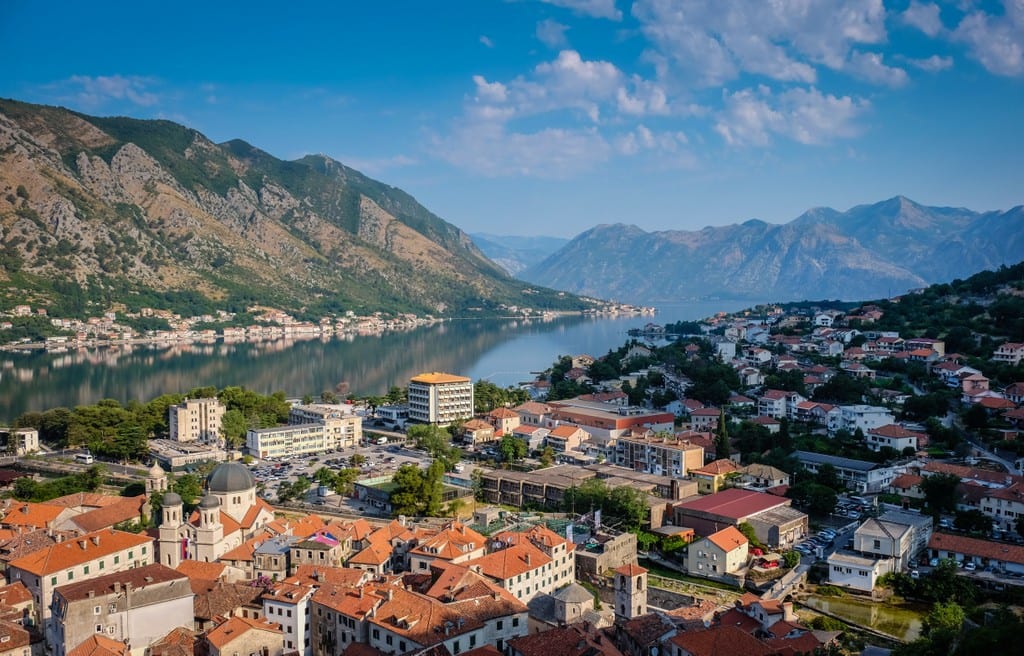
Montenegro is one of the most beautiful countries in the world.
I have frequently called Montenegro the most beautiful country in the world — or the most beautiful country in Europe. That’s high praise — and I don’t give it out lightly. (And yes, I’ve been to Iceland, Norway, Switzerland, you name it.)
While Croatia’s Adriatic coastline might get all the hype, Montenegro’s coastline has quite a bit of beauty as well. The Bay of Kotor is nothing short of spellbinding, with lush green mountains crashing down into clear teal water.
But that’s just the bay (which also happens to be the southernmost fjord in Europe). There are also the mountains. Once you head further inland, Montenegro is filled with stunning gray mountains interspersed with little tufts of greenery.
In fact, Montenegro’s name (Crna Gora) means Black Mountain, and was named for the dense evergreen forests on Mount Lovcen.
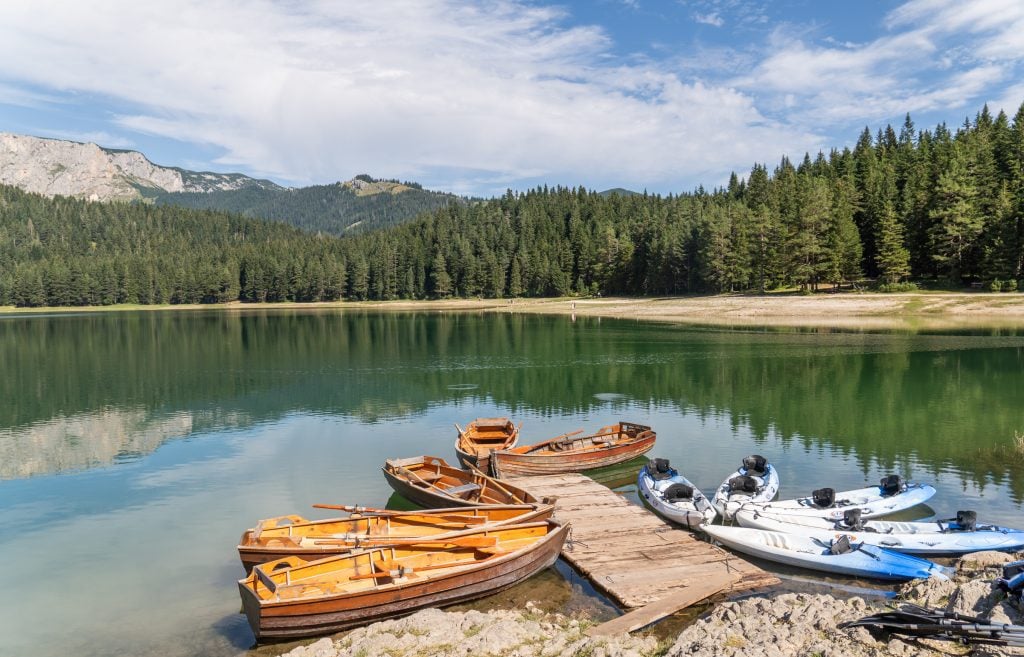
Where to go in Montenegro
Not super familiar with Montenegro? Check out my list of 30 best things to do in Montenegro . Here are some of the best places to visit in the country:
Bay of Kotor: This spectacularly gorgeous bay is the most touristed part of the country. Many, many day-trippers come over from Dubrovnik, and plenty more travelers just pop into Kotor and pop out a few days later. Cruise ship travelers base in Kotor as well.
Kotor is the most famous town to visit in the region and makes a good base for exploring both Kotor Bay and Montenegro as a whole. A tiny town close to Kotor is Perast , and gets a lot of day-trippers but also makes a good base for a few days. Herceg Novi is a big resort town close to the Croatian border; Tivat is home to the region’s international airport and gets a lot of moneyed yacht visitors.
A bit more inland but close to the bay, you have Lovćen National Park and the old royal capital of Cetinje , both worth a visit.
Budva Riviera: Budva is a major beach town in Montenegrin coast that has been drawing huge crowds of tourists for decades (and attracts lots of Russians in particular). This part of the country is home to high quality beaches . Some towns to visit beyond Budva itself include Sveti Stefan and Petrovac .
Northern Montenegro: This part of Montenegro is mountainous and rural, and is home to national parks including UNESCO World Heritage-listed Durmitor National Park , home to Black Lake and Tara River Canyon rafting, and, further east, beautiful and underrated Biogradska Gora National Park .
Central Montenegro: Central Montenegro is one of the lesser-visited parts of the country, but there are some cool places to visit here, like Ostrog Monastery , set into a rocky cliff.
Southern Montenegro: If Montenegro is shaped like a diamond, the bottom quadrant is home to quite a few various sites.
Here you have the scruffy yet popular beach towns of Bar and Ulcinj , which are a bit scruffier than the Budva Riviera and draw a more local Montenegrin and Albanian crowd. The current Montenegrin capital of Podgorica doesn’t have much to see, but nearby Stari Bar is a bit of a ghost town with ruins that were wrecked in the 1979 earthquake.
Skadar Lake National Park is home to the largest lake in the Balkans and is a very interesting place to spend an afternoon.
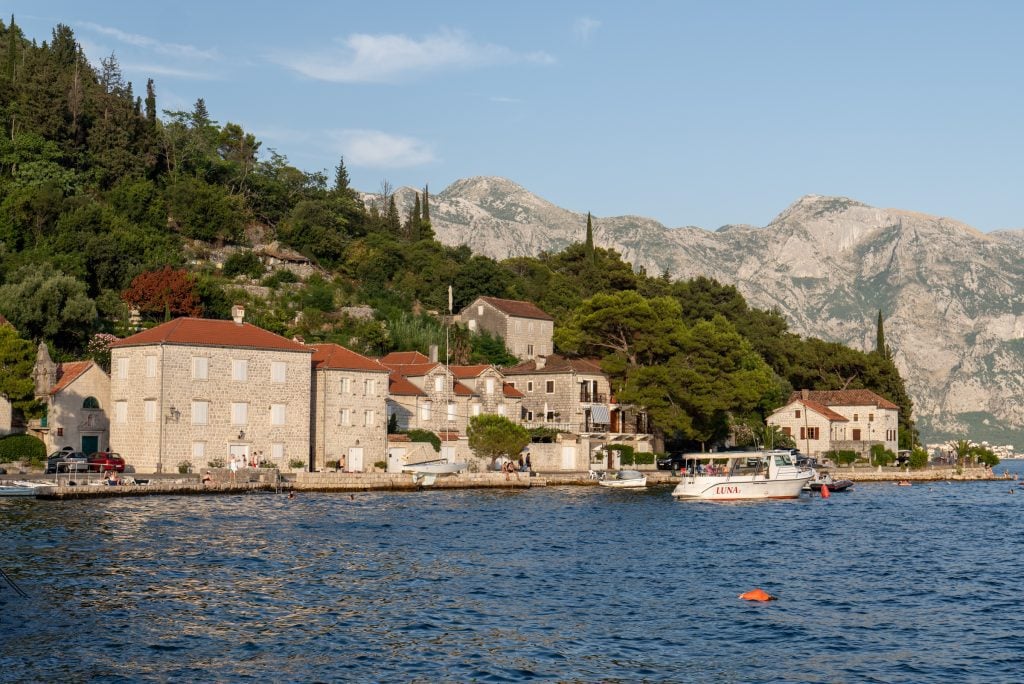

Is Montenegro the new Croatia? Not really.
Everyone loves to declare places the “new” something. Riga is the new Prague! Medellín is the new Chiang Mai! Mahahual is the new Playa del Carmen! And plenty of people have been calling Montenegro the new Croatia for years. (And, in turn, Albania the new Montenegro.)
Is that true? I don’t really think so. While Montenegro might have similar dramatic coastline, along with rocky but not sandy beaches, Montenegro is light years away from Croatia in terms of infrastructure for travelers.
What does that mean? There are no ride-sharing apps that work in the country, buses won’t honor internet-purchased tickets unless you print them out, the highways have a single lane in each direction and get backed up, and while there are some nice hotels here, most accommodation tends to be at a more basic level. Many tourism businesses don’t have much of an online presence, either, beyond a WhatsApp number to call.
I’m not saying this to insult Montenegro — far from that! I love it here. Just know before you come that travel here is a lot more basic — especially if you’re used to traveling in Western Europe.
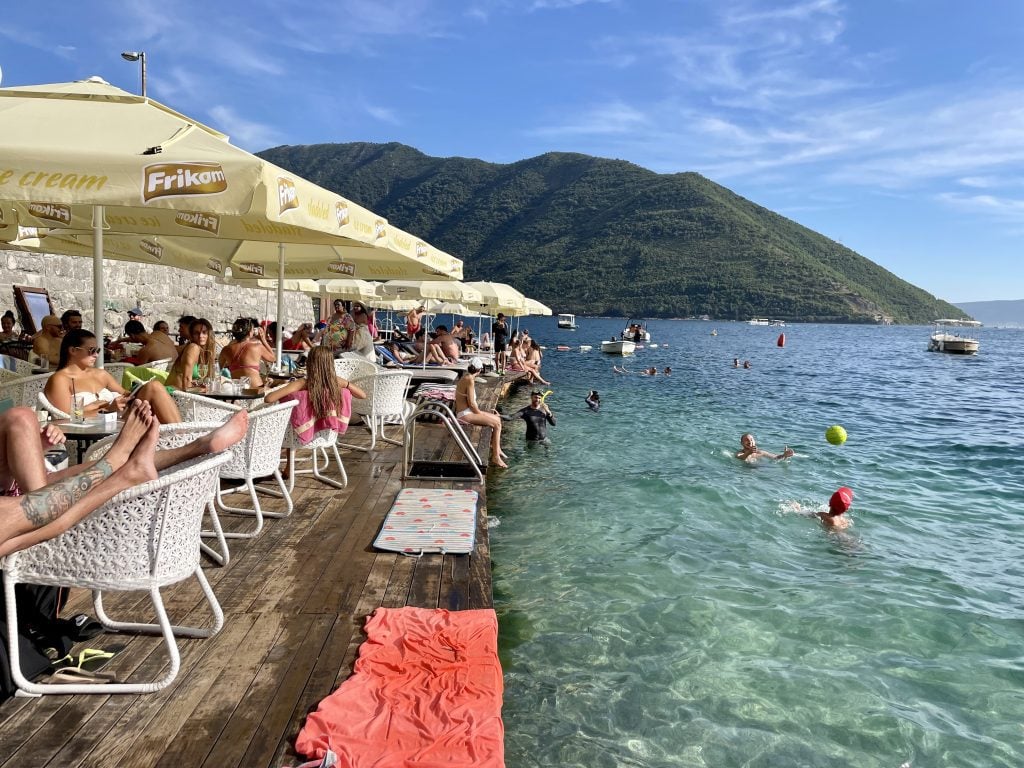
When’s the best time to visit Montenegro?
To me, Montenegro is a quintessential summer destination. Between swimming in the Adriatic Sea, hiking through the mountains, and hopping through the gorgeous towns, Montenegro is like drinking in sunshine. That’s why I wanted to return for my recent birthday in August.
Montenegro has a Mediterranean climate, though much of the weather depends on the elevation. The coastal regions tend to be much warmer and rainier than the inland mountain regions, which are cooler and get a good amount of snow in the winter months.
July and August are peak season in Montenegro; June through September is high season. However, I don’t recommend visiting during July or August if you don’t have to. I most recently visited in August and the traffic along the coastline was NUTS. Cruise ships were NONSTOP. The towns were PACKED. Taxis were charging INSANE prices (more on that below).
If you enjoy summer weather, I recommend visiting Montenegro from early to mid-June or mid-September to early October. It will still be summery and gorgeous — just a lot more peaceful of an experience!
What about shoulder season? Absolutely! If you don’t care about swimming in the sea or sunning yourself, spring and fall can be great times of year to travel in Montenegro. Shoulder season is especially good for hiking and outdoor adventure.
Winter will be very quiet, with many businesses on the coastline closed — but it’s a great time for skiing in the mountains. Skiing in Montenegro is absolutely a thing (look to the Dinaric Alps), and it will cost you a fraction of what you’d pay in the Swiss or Italian Alps.
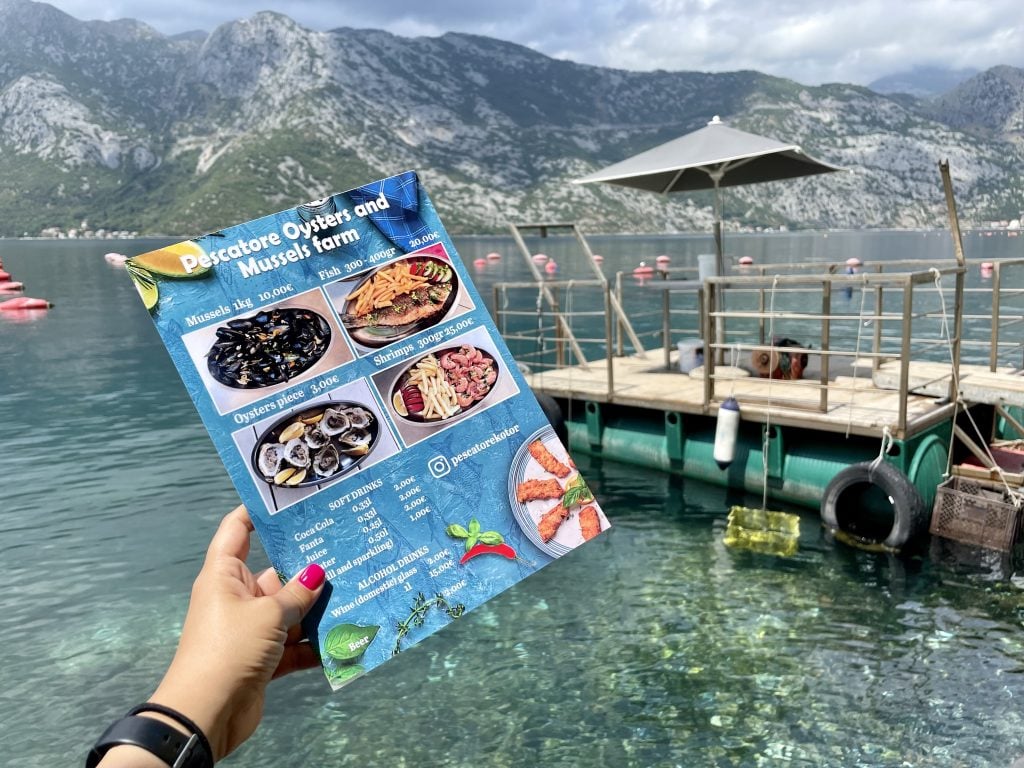
Is Montenegro expensive or cheap? Yes.
For decades, guidebook authors have been encouraging Europe travelers on a budget to head east. You’ll get far more for your money in Budapest than Paris!
The reality of that today? KIND of true, but not always. (After all I live in Prague, once a famously cheap European getaway, but now I often spend less in Italy than I do in Prague. Italy!!)
The Western Balkans — consisting of the former Yugoslavia and Albania — often get you quite a bit for your money. North Macedonia, Serbia, Bosnia, Kosovo, and Albania are very budget-friendly destinations, while Slovenia has grown more expensive and much of Croatia has become significantly more expensive, especially Dubrovnik.
So how expensive is Montenegro? It depends on where you go.
Kotor and Perast? Very expensive. These popular hotspots on the Bay of Kotor get a lot of tourism, and thus prices are driven far up. Budva and its southern beaches are only a bit cheaper than Kotor and Perast, though there are some deals to be had.
Southern beach destinations in Montenegro like Ulcinj and Bar that draw local visitors are a bit shabbier and a good amount cheaper than the beaches further north.
But once you head deep into inland Montenegro — think Durmitor National Park and Biogradska Gorda — prices drop significantly and are more on par with Serbian prices. Even heading slightly inland from the coast can make a big difference in prices.
It’s the same as anywhere else in the world: cities, coastal destinations, and tourist hotspots tend to be most expensive. Rural, inland, less popular destinations tend to be cheaper.
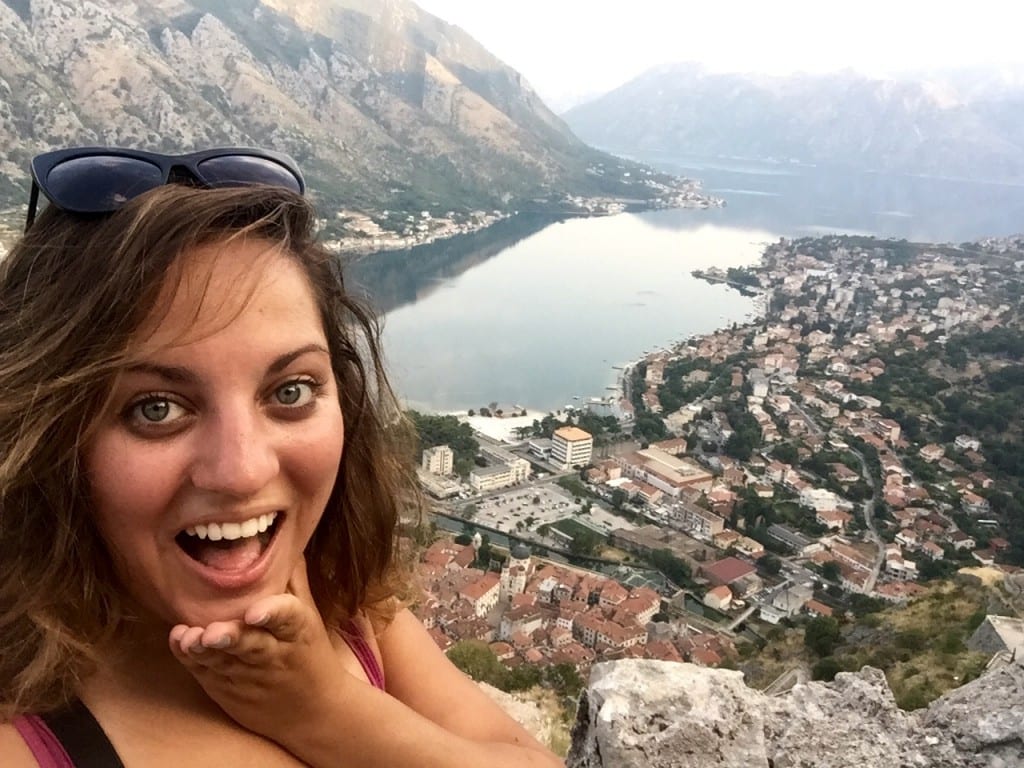
Is Montenegro safe?
Montenegro is as safe as most destinations in Europe — which means it may be safer than your hometown. Do what you would do in any other destination — keep your valuables on you in transit, don’t drink too much, stay aware of your surroundings, keep in touch with someone at home.
I’ve traveled in Montenegro as a solo female traveler and I felt very safe the whole time. I’d travel solo in Montenegro anytime. (Have you seen my top 10 travel safety tips for women ? Definitely check them out if you haven’t yet.)
Are there any Montenegro-specific safety precautions to take? A few.
Be cautious of petty theft. Pickpocketing can happen in busy towns like Kotor and Budva, especially in their dark, twisty old towns. Keep your belongings in a zip-up crossbody purse, don’t take more money and cards than you need for the day, and lock up the rest in your room in a portable safe.
Be careful on the roads. Roads in Montenegro tend to be narrow and winding, especially once you get deeper inland. Many of these switchback-filled roads that are safe, but you need to go much more slowly than usual. Be careful where you stop to take pictures, too. There are rarely guardrails at scenic overlooks. Allot extra time for your drive so you don’t have to speed.
Practice safety when hiking. Talk with a local before you head out on a hike, check the weather, make sure it’s currently safe and passable, and let your hotel know where you’re going and when you should be back. Be cautious of snowstorms in the mountains from fall through spring.
Don’t go drink for drink with Montenegrins, especially if rakija is involved. Like Serbians, Montenegrins LOVE to share rakija with visitors and will offer it often, especially if you’re a man (my husband even got offered rakija at BREAKFAST once!). You do not have anywhere close to their rakija tolerance — I recommend trying one shot, max, only if you’re not driving, or politely turning them down.
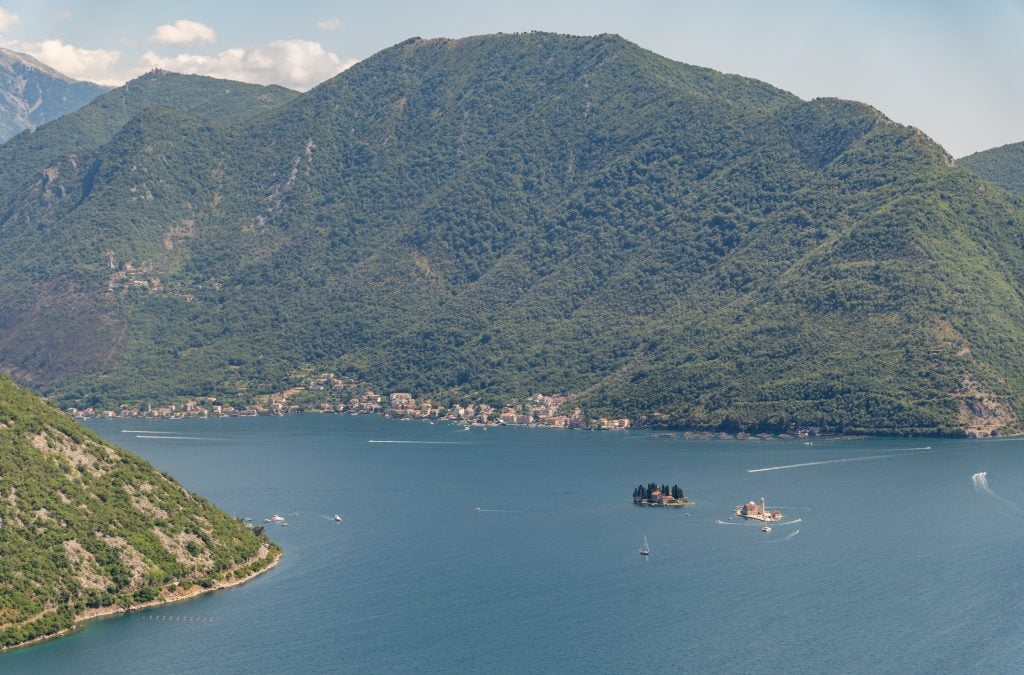
How to get to Montenegro
There are two international airports in Montenegro: Tivat, which is on the Bay of Kotor; and Podgorica, the capital. If you’re flying directly in, you’ll want to aim for one of those two airports. Neither airport is super well-connected, especially outside the summer months, but you can find your way via some larger cities.
Some people like to fly to Dubrovnik and head to Montenegro from there. I’ve done that before myself. The border is a bit of a pain, but it might fit into your trip better, especially if you’re adding on time in Croatia.
Alternatively, you can get to the city of Bar, Montenegro, two different ways: there is a Montenegro Lines ferry from Bari, Italy , as well as a train from Belgrade, Serbia.
Otherwise, you’ll be arriving overland by car or bus. For this reason, travelers often pair Montenegro with another country or two (I always have!). You can easily add Montenegro to a southern Croatia itinerary , or add Montenegro to a longer trip through Serbia, Bosnia, or Albania.
(Just let your rental car company know if you plan on crossing borders.)
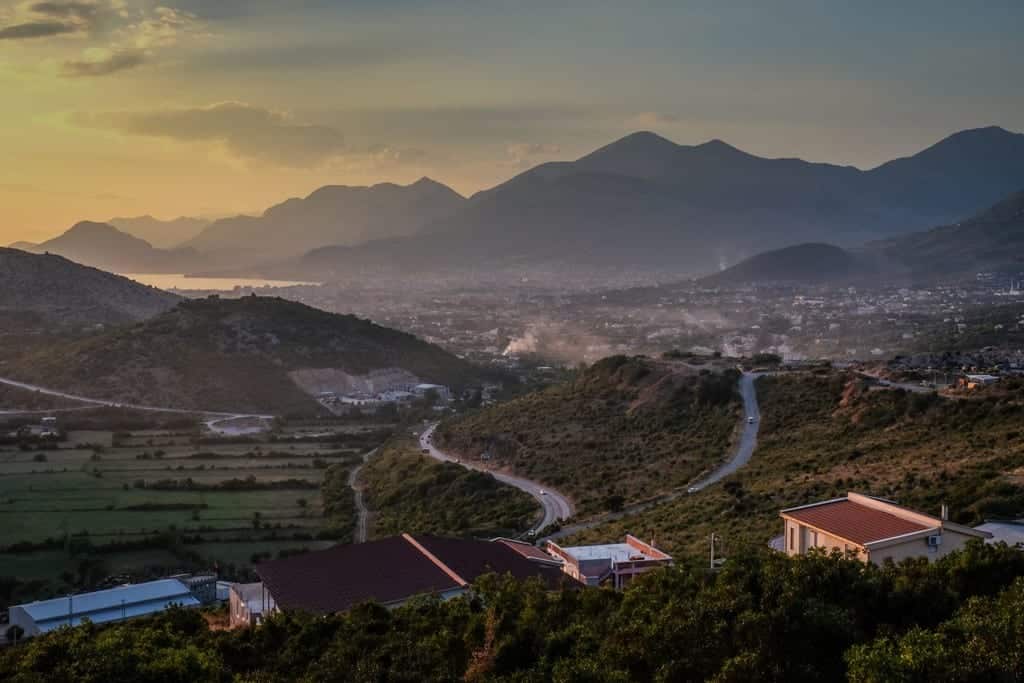
Montenegro is not in the Schengen Zone.
Like many of the Balkan countries, Montenegro is not part of the Schengen Zone. The Schengen Area is a group of 27 nations in Europe that have open borders.
Long-term travelers and digital nomads in Europe can only be in the Schengen Zone 90 days within a 180-day period. As a result, lots of these people are looking for nice non-Schengen areas to spend their time until they can return to the Schengen Zone.
So yes! Montenegro is not Schengen, so it makes a nice place to visit if you need to leave the area for awhile.
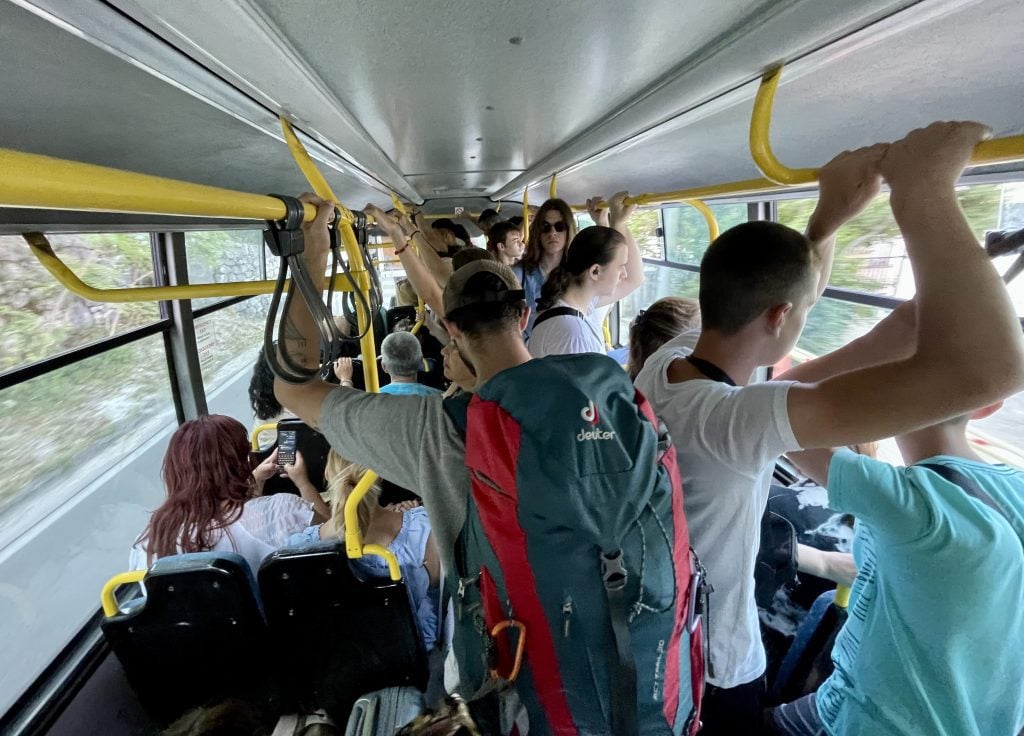
Can you do public transportation in Montenegro? Yes, but it’s a pain.
Montenegro travel can be done either with or without a car. I’ve done two Montenegro trips without a car and one with a car and honestly, having a car makes travel in Montenegro so much easier.
If you just want to do a quick Bay of Kotor trip, or maybe Kotor and a day trip to Durmitor, you can get away without a car. If you want to travel Montenegro comprehensively, you will absolutely need a car.
So what kind of public transport is there in Montenegro?
Bus: Buses are the main way to get around Montenegro, including points beyond the country’s borders. You can buy tickets at bus stations in cities that have them.
The Blue Line bus travels along the Bay of Kotor, from Herceg Novi to Kotor, stopping at most towns along the way, though know that buses can be late and packed to the gills.
Important note: you MUST have tickets printed out if you buy them in advance. Having them on your phone screen won’t work. I bought tickets through BusTicket4Me , a Montenegrin company, and they wouldn’t let me on because it wasn’t printed out!! If you don’t have a printer, you can have the bus station print them out for you, but it might be a long wraparound line, as it was the day I did it.
Train: Surprise, there’s a train in Montenegro — and it’s actually a gorgeous journey! There is a train that runs between Bar and Belgrade, Serbia, stopping at Podgorica and Bijelo Pole en route. This can be an all-day or overnight journey (13 hours by day, 9 hours overnight).
Ferry: If you want to skip the long drive around Boka Bay (on the Bay of Kotor), there is a short ferry between Kamenari and Lepetane. Ferries run constantly as they fill, take 10 minutes, and cost 4.50 EUR ($5 USD).
Internationally, there is a ferry that runs between Bar and Bari, Italy, on Montenegro Lines. The journey takes nine hours.
Tourist shuttles: Montenegro Hostel offers tourist shuttles (good-quality buses and vans that take you direct from hotspot to hotspot so you don’t have to change buses several times). I took their shuttle from Tirana to Budva once and it was a lovely, comfortable, air-conditioned experience. You can take them from destinations in Montenegro to Dubrovnik, Croatia; Mostar, Bosnia; and Tirana, Albania.
Hop-On, Hop-Off Bus: There is now a hop-on-hop-off bus in Montenegro running along the Bay of Kotor between Risan and Kotor. At 25 EUR ($27 USD) for 24 hours, I think it’s a deal if you are traveling solo and would be taking taxis otherwise. Honestly, I would LOVE it if it continued to Budva or even Sveti Stefan or Petrovac. Hope they expand it in the future.
Taxis: Frustratingly, Montenegro doesn’t have Uber or any ride-sharing or ride-hailing apps. Taxis can and will charge high fees, especially on the Bay of Kotor. In 2023 I was quoted 50 EUR ($53 USD) for a 30-minute one-way trip from Kotor to Budva!
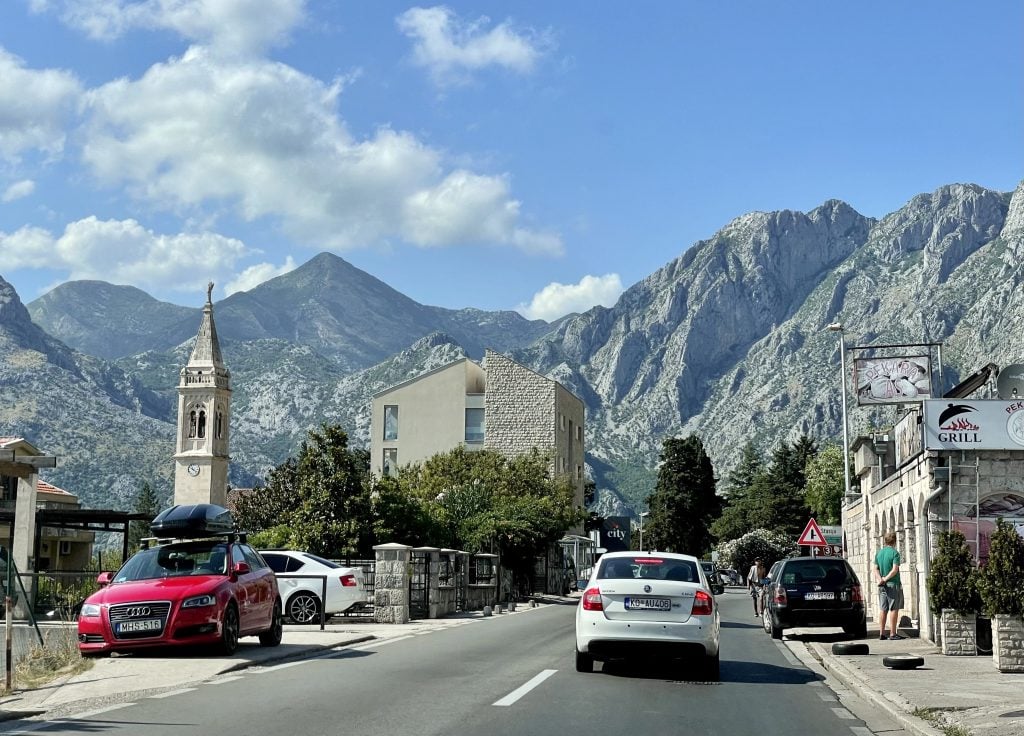
Driving in Montenegro has its challenges.
If you’re going to rent your own car in Montenegro, great! You’re going to get to see so much more this way.
However, you should plan for all of your drives to take much longer than you expect. Montenegro might be the size of Connecticut, but you shouldn’t expect to get from Herceg Novi to Ulcinj as quickly as you can get from Greenwich to New London. (Or maybe you can. I went to college in Connecticut and traffic there is pretty gnarly.)
There aren’t any wide highways in Montenegro. Major roads in the mountains may look like highways on Google Maps, but they are often very narrow and curvy with one lane of traffic in each direction. You often have to slow down to drive these roads safely, and once we even had to drive through a landslide!
That said, these roads tend to be in good condition and driving is smooth. Your main concern is switchbacks in mountainous areas, and there are tons of tunnels.
During the summer months, traffic is terrible along the coast. Once again, the only road along the coastline has a single lane in each direction. Know this ahead of time, and plan a flexible schedule in case you get stuck. (Otherwise, visit during another time of year. Even June and September can be better than July and August.)
As for Montenegrin drivers? They can occasionally get a bit aggressive, but it’s nothing on the level of what I saw in Albania or, shockingly, Slovenia.
Parking in Montenegro can be a huge pain during the summer months, especially along the coast (we literally had to sit and wait for someone to leave Perast in order to park there). Again, consider visiting outside of July or August, and consider just paying for parking to have less of a headache.
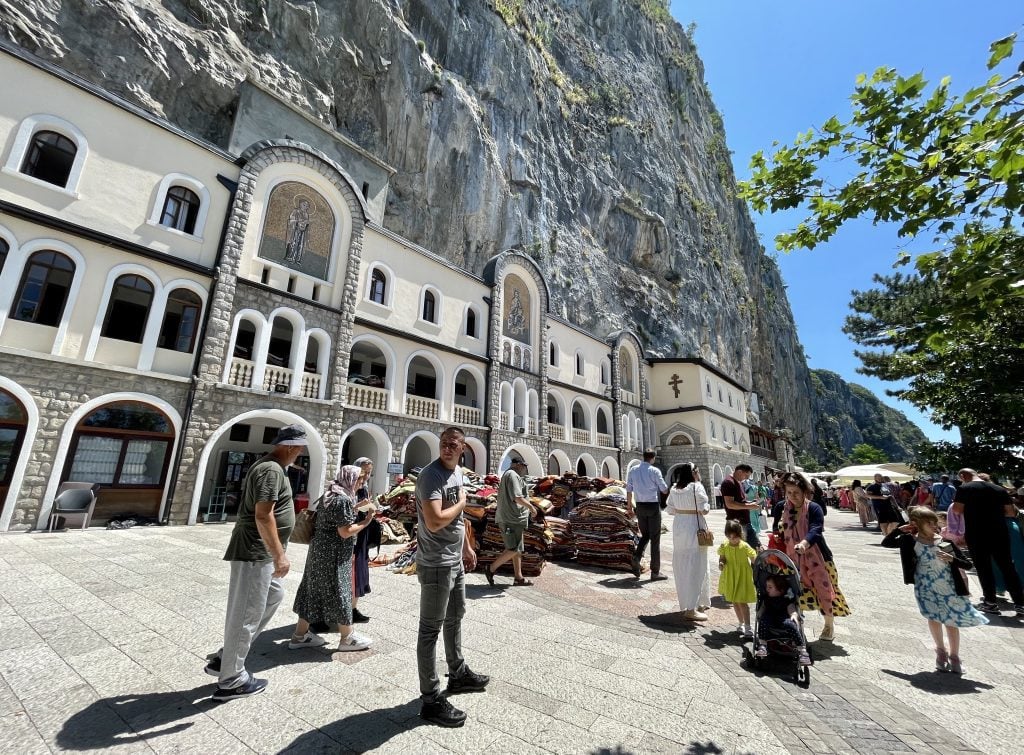
Do people speak English in Montenegro?
The local language in Montenegro is Montenegrin, one of the Serbo-Croatian languages. That said, isn’t much of a language barrier in Montenegro — in areas catering to foreign tourists, that is — so if you only speak English, you’ll be okay.
Like in many parts of Central Europe and the Balkans, everyone who works in tourism speaks English. In more rural, less touristy areas, you’ll find that younger people (under 40) tend to speak English while older people do not.
While Montenegrin uses two alphabets — the Latin alphabet and the Cyrillic alphabet — most signage in Montenegro uses the Latin alphabet. This is a big difference from Serbia, which leans more on Cyrillic.
You’ll find that menus in Montenegro tend to be in the local Montenegrin language, English, Russian (Russians especially love the Budva Riviera), German (Germans go everywhere), and Italian ( perché no? ).
Finally — speak any Slavic languages? You might be able to get by occasionally in Montenegro! My husband Charlie speaks Czech, and a few times he was able to speak Czech with Montenegrins and they got the gist of what the other person saying.
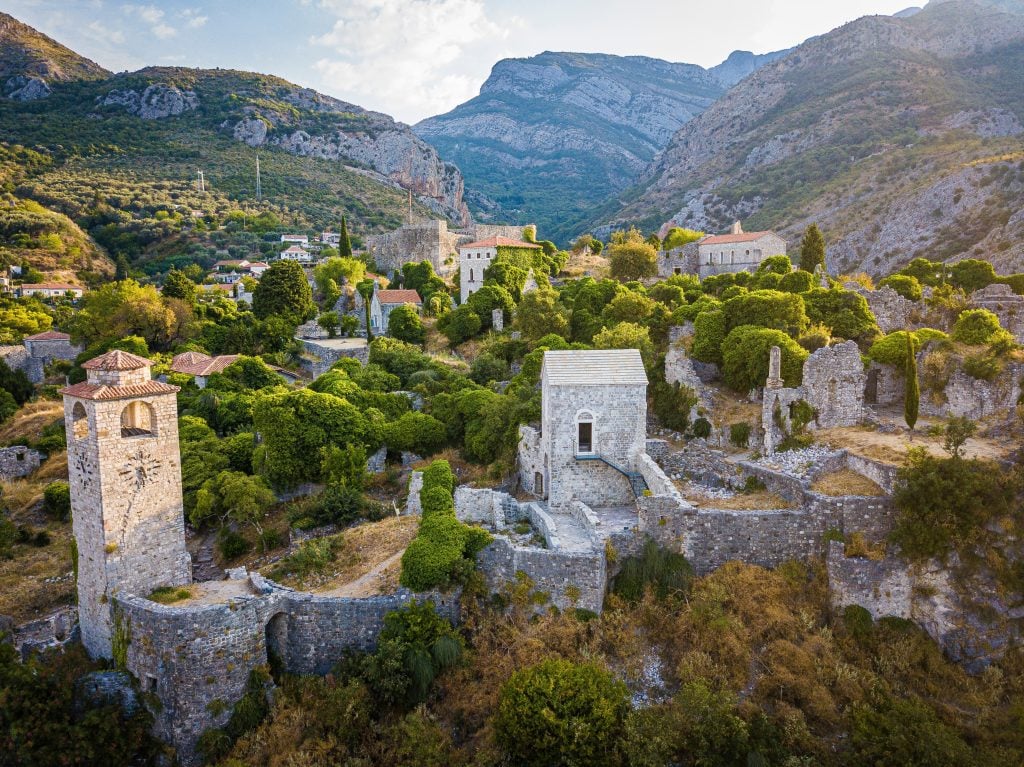
How does money work in Montenegro?
Montenegro is not part of the European Union, but they use the euro as currency. I keep the Currency app on the home page of my phone and use it constantly to double-check what prices are (not as much in Montenegro, as euros are pretty close to US dollars, but you bet I use it a ton in the Czech Republic where the rate is a hard-to-calculate 22:1!).
Here are some money tips for Montenegro:
Avoid Euronet ATMs. These ATMs are found throughout Europe and will RIP YOU OFF. Instead, use an ATM attached to a physical bank. (Added bonus: in the unlikely event your card gets eaten, it can be saved from a bank ATM.)
If it asks whether to charge you in euros or your home currency, ALWAYS choose euros or whatever the local currency is. This might appear on an ATM screen as “Will you accept the conversion?” Always say no — it will still work. Or when paying by card, it may ask you which currency to charge. Always the local currency.
I know, this doesn’t feel intuitive. But they end up charging you a lot more when they convert the rate.
You can use your credit card for most transactions in Montenegro. I use cards whenever possible — both for points and to keep better track of my spending in YNAB, my budgeting software (which I ADORE). However, it’s always a good idea to carry a small amount of euros for small purchases or when businesses don’t accept cards.
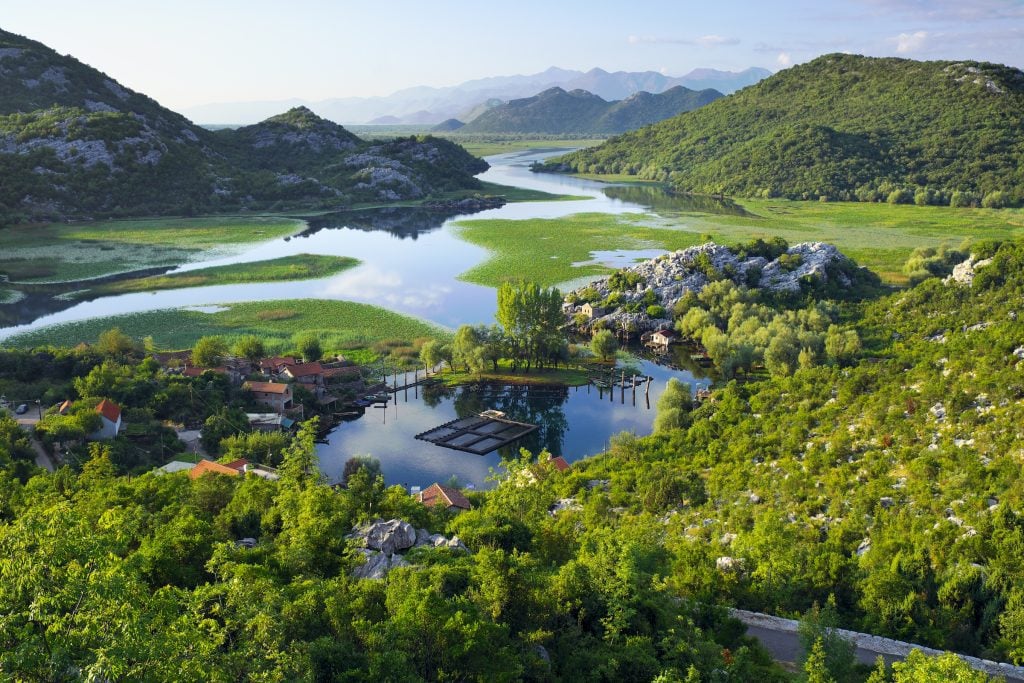
Will your phone work in Montenegro?
Do not use your home phone plan abroad — they will likely charge you ABSURD fees. Additionally, if you have an EU SIM card, know that it will not work in Montenegro.
But should you just rely on wifi in Montenegro? I don’t recommend it. Having working internet on your phone is a safety issue.
Instead, get an eSIM. I used to always get a real SIM card in Montenegro, but eSIMs exist now and they’re fantastic, as you can buy them at home without going to a store.
Nowadays I buy my eSIMs from Airalo. You can see their Montenegro eSIMs here. At the time of publication, you can get 3 GB of data for $15.
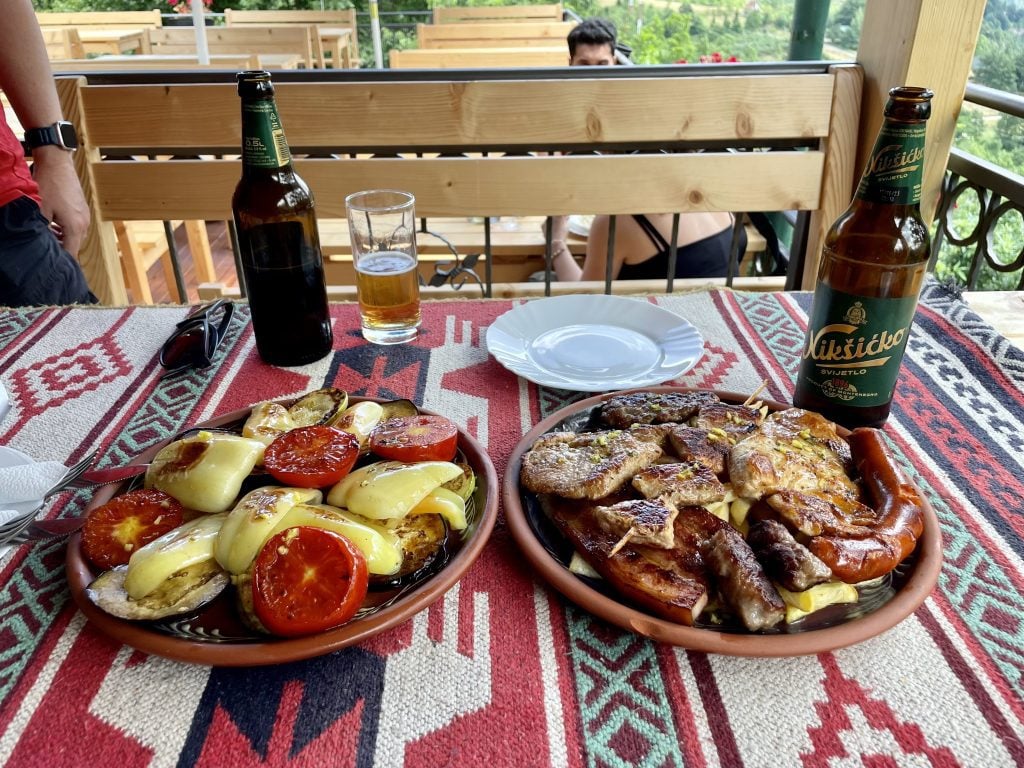
What is Montenegrin food and what will you be eating?
Diving into Montenegrin cuisine? Get ready to eat a lot of meat. (Unless you don’t eat meat, that is — you can avoid it if you want to.) Montenegro, like many Balkan countries, is really big on the meat consumption, especially up in the mountains.
It’s common to get a mixed grill featuring pork, lamb, veal, and chicken, as well as a big platter of tomatoes, peppers, and zucchini. Another meat dish is ćevapi (cheh-VA-pee), rolled minced grilled meat, often served in a pita. My husband is obsessed with pljeskavica , a Balkan burger made from pork, beef, and lamb.
Two sauces to try with your meat are kajmak (KY-mack), which is like clotted cream, and ajvar (I-var), made from roasted red peppers.
Along the coastline, you’ll find plenty of local seafood, with fish stews featuring prominently on many menus. A lot of mussel and oyster farms in the Bay of Kotor have simple restaurants operating out of shacks. You’ll never find fresher seafood than this!
In more touristy destinations, you’ll find slightly more international food options — along with a lot of pizza and pasta. (The quality varies, to be honest. Don’t be surprised if they bring you ketchup for your pizza.)
If you’re looking for a cheap snack or breakfast option, I recommend heading to a local bakery and grabbing a burek — a flaky pastry common throughout the Balkans. It can be filled with spinach, cheese, roasted red peppers, or anything else!
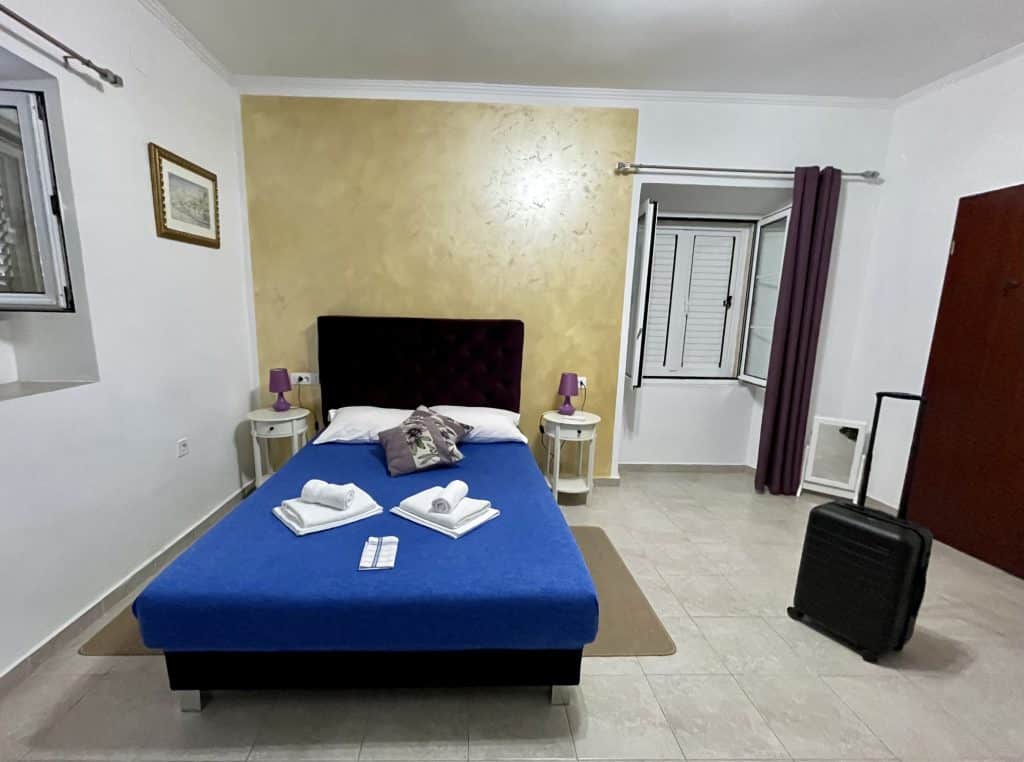
Apartments rule for accommodation in Montenegro.
In Montenegro, like most of the Balkans, apartment accommodation tends to be more popular than hotels. And no, it’s not an Airbnb thing — this is the way things have always been here.
In the pre-smartphone era, it was common for local women in Central and Eastern Europe to stand in train and bus stations with signs reading “apartment.” Even as recently as 2020 in Makarska, Croatia, I saw women on the side of the road holding up signs reading “Apartmenti”!
Sometimes these apartments are considered guesthouses, with several private, lockable rooms available for travelers. To book these places, you can find a lot of them on Booking.com these days . And yes, they are safe. I stay in guesthouses frequently and wouldn’t if they weren’t safe.
And keep in mind that when you stay in an apartment or guest house in Montenegro, you’re (usually) giving money to a local — not buying a hotel chain CEO a third yacht.
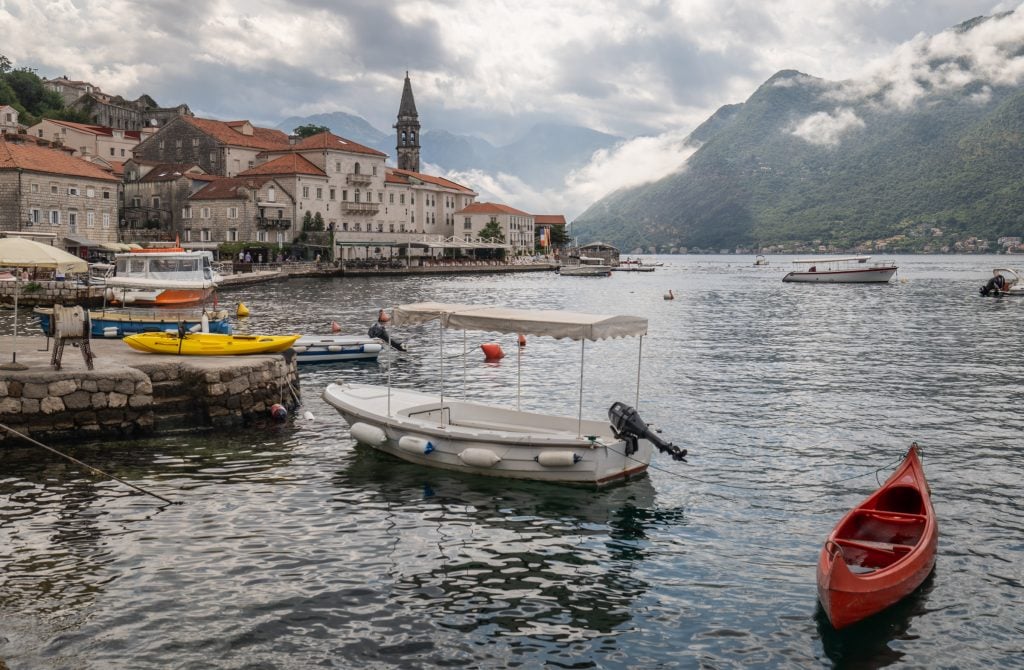
Montenegro is home to four UNESCO World Heritage Sites.
If you love visiting UNESCO World Heritage Sites around the world, Montenegro has four of them: two that are entirely Montenegrin and two that are split between different countries.
First off is the Natural and Culturo-Historical Region of Kotor, and includes the towns of Kotor, Perast, and Risan in addition to the various fortifications and palaces and how they were integrated into the mountainous landscape.
Durmitor National Park is also a UNESCO World Heritage Site, singled out for its biodiversity, glacial lakes, and the second-deepest canyon in the world.
The Stećci Medieval Tombstones Graveyards include a collection of sites in Bosnia and Herzegovina, Croatia, Montenegro, and Serbia. In Montenegro, there are two sites in Žabljak and one in Plužine.
The Venetian Works of Defence between the 16th and 17th centuries are found in Italy include a collection of sites in Italy, Croatia, and Montenegro. The fortifications of Kotor are the lone Montenegrin site.
And keep your eye on the tentative UNESCO list for the future — some Montenegrin sites that have been nominated include the Cetinje historic core, Biogradska Gora National Park, and Ulcinj old town, among others.
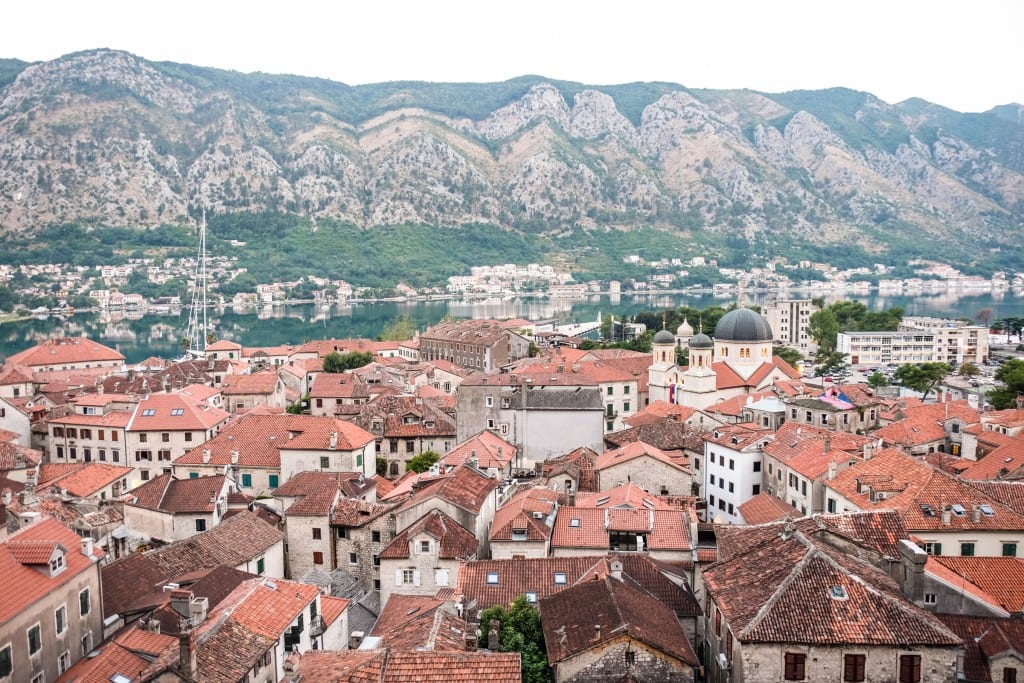
You can see a lot while using Kotor as a base.
Want to have an easier trip to Montenegro without worrying about a car? I recommend using Kotor as a base for your Montenegro trip and exploring from there.
Why Kotor? It has the most tourism infrastructure in the country. Buses head off in several directions from here (if going from Perast to Kotor, for example, you must change buses in Kotor). And many tours depart directly from here.
Spend a few days exploring what Kotor has to offer (and it has a LOT to offer). Hike up to St. John’s Fortress first thing in the morning, visit the Kotor Cats Museum, photograph everything in sight.
Spend one day on a Durmitor National Park day trip. This trip takes in Black Lake, Tara Canyon (no rafting) and Ostrog Monastery ; alternatively, you can do a Tara Canyon rafting day trip .
Spend one day on a Great Montenegro Tour , which includes the Kotor Serpentine, Ngejusi, Lovcen National Park, Njegoš Mausoleum, Cetinje, Lake Skadar, and a brief photo stop at Sveti Stefan.
One afternoon, take a boat trip to the Blue Cave, submarine tunnel, and Our Lady of the Rocks .
One day, take the hop-on-hop-off Montenegro bus to Risan, Perast, and Bajova Kula. (Or just take the Blue Line bus for cheaper, perhaps as far as Herceg Novi if you’d like.)
One day, take a bus to Budva and Sveti Stefan.
You can see QUITE a lot of Montenegro — and you’ll be able to lay your head in the same place every night. Not bad at all!
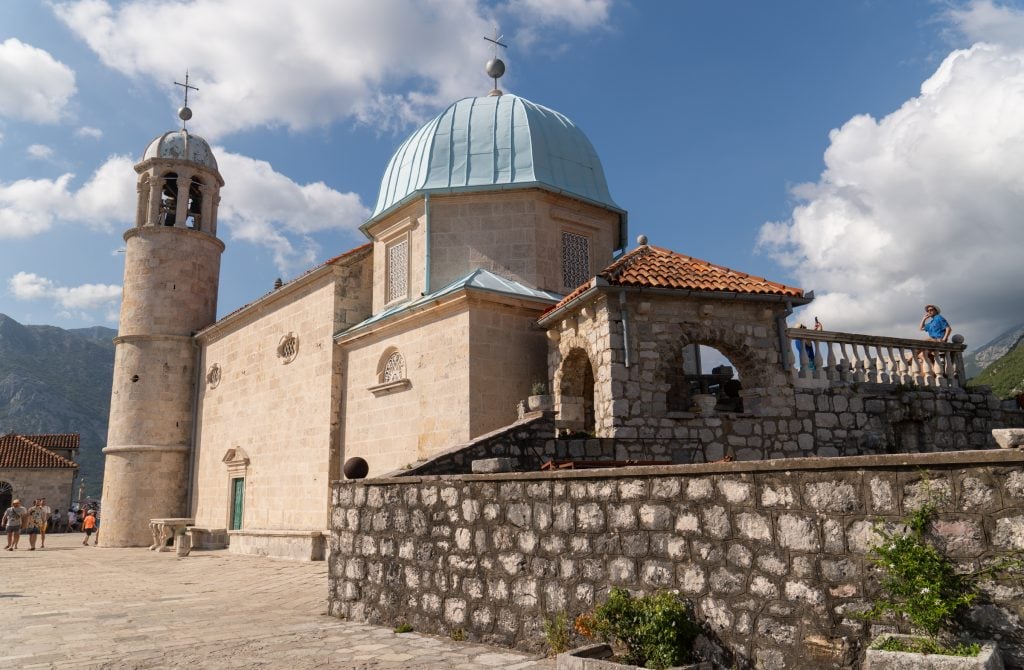
Should you take a day trip to Montenegro from Croatia?
There are so many Montenegro day trips that leave from Dubrovnik. Most of these trips take in Kotor and Perast. If you don’t have much time and you really, really want to experience Montenegro, then yes, you can absolutely do this.
This day trip from Dubrovnik to Montenegro is a good one , including Our Lady of the Rocks (or, alternatively, time in Perast), Kotor, and Budva.
However, you should know that summer traffic between Dubrovnik and Kotor can be rough. I’ve seen it get worse and worse over the years.
Additionally, you’ll need to go through passport control on both sides. And ever since Croatia became part of the Schengen Area in 2023, they’ve been extra strict and thorough with people at crossings.
A day trip to Montenegro means you’ll be sitting in traffic for a LOT of the day, especially if you visit during the summer.
Consider staying overnight, at the very least, if you’re visiting Montenegro from Croatia. You’ll get to see so much more. But if this is your only chance, take the day trip. You’ll still love it.
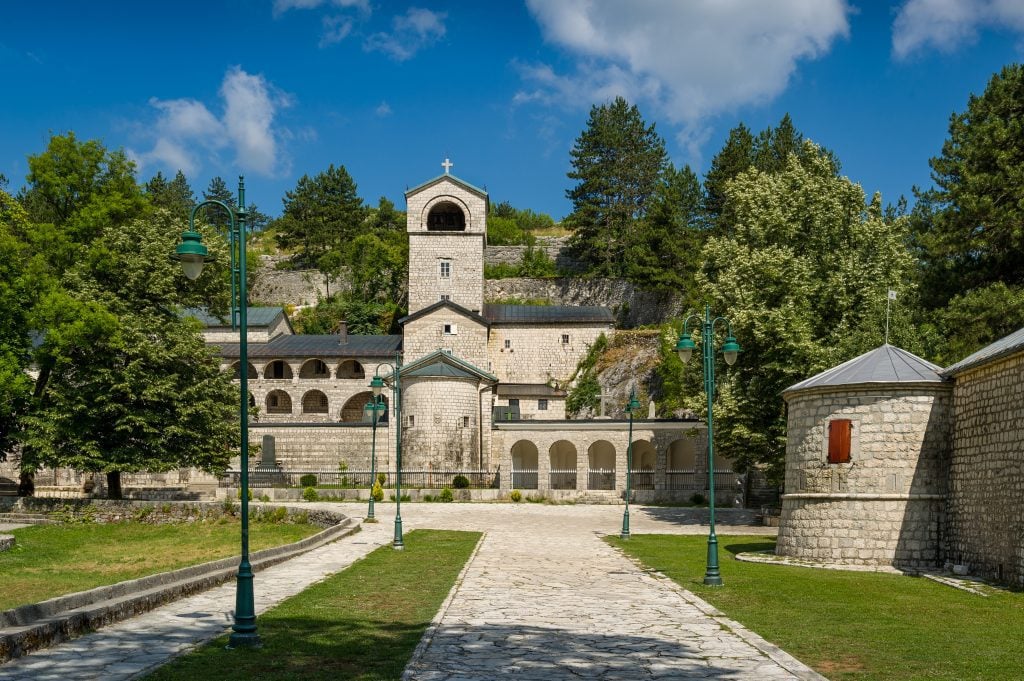
How much time do you need in Montenegro?
How much time should you actually spend in Montenegro? More than a day trip, of course, but how much do you really need?
I recommend spending around one week in Montenegro. I’d recommend spending 3-4 days on the Bay of Kotor — staying in Kotor is easiest, though I loved staying in Perast as a repeat visitor — and your remaining days in one or two other places.
Durmitor National Park makes a great choice; you can also head down into Southern Montenegro with easy access to explore the surroundings, especially if you have a car. Somewhere like Bar, for example, gives you a lot of options.
Is it too far to fly to Montenegro for just one week of travel? You can absolutely extend your trip if you’d like — or add on a short stint in another country. Croatia, Serbia, Bosnia, or Albania would be my top recommendations to add on to a trip to Montenegro.
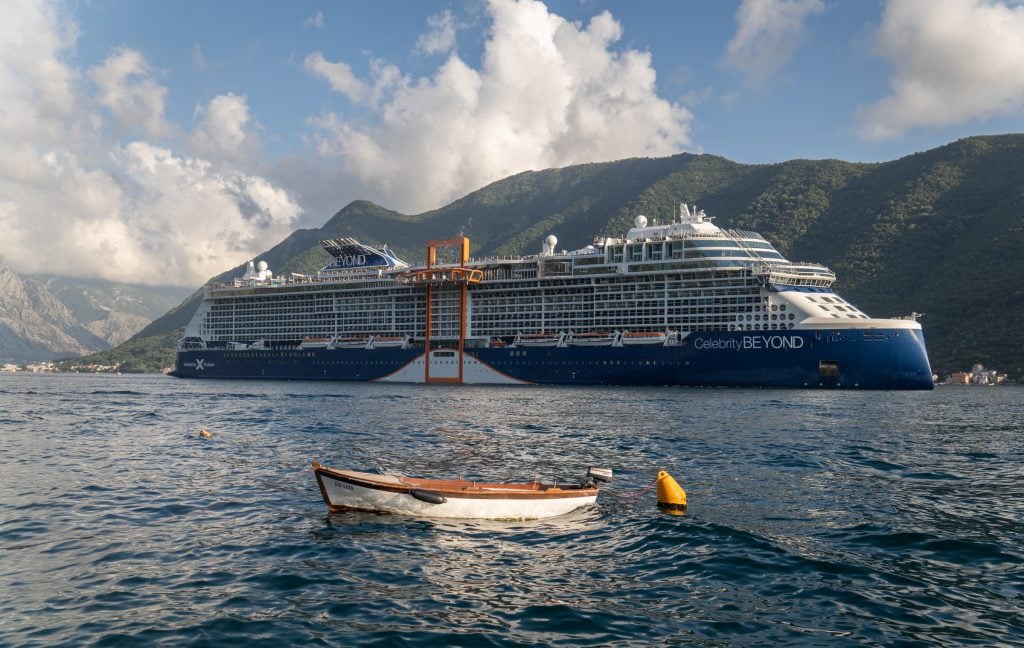
Please don’t take a cruise ship to Montenegro.
Yes, this is something that you hear me say frequently, and it deserves to be repeated. Cruise ships are terrible for most destinations around the world — and that includes river cruises. Cruise ships dump hundreds or thousands of travelers on a destination. They crowd the streets and spend little to no money. Who are they helping, really?
And it is especially egregious to see monstrously large ships sailing through the delicate Bay of Kotor and dropping people in the small city of Kotor. It is TOO SMALL to handle numbers those large.
Recently, Dubrovnik reduced the number of cruises they host. That was a smart move, and should be applauded.
But Kotor picked up the slack. All those cruises are now going to Kotor instead of Dubrovnik.
Do you want to see Montenegro by boat? Can I suggest a Montenegro sailing trip instead, or maybe a Croatia and Montenegro sailing trip ? This way you can still travel by boat and have a much gentler impact on local communities. And these trips are insanely fun.
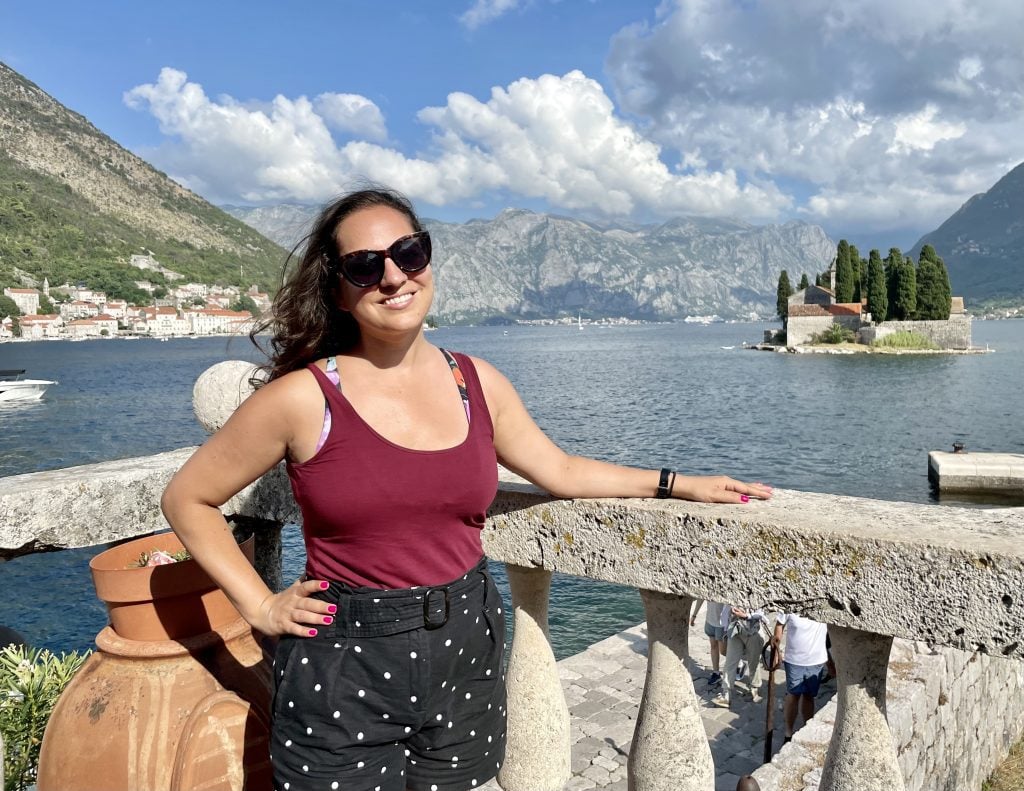
Travel to Montenegro and you’ll be back soon.
Montenegro travel is so worth it — and once you’ve had a taste of it, you’ll be hooked. Even years after my first Montenegro visit, I know I wanted to return to celebrate my birthday here. It’s that kind of place. It just makes everything feel special.
I hope you have the best time in Montenegro! Definitely come back and tell me all about it.
More on Montenegro:
- 30 Fun and Interesting Things to Do in Montenegro
- I was Haunted by a Ghost in Montenegro for 3 days
- 17 Beautiful Things to Do in Kotor, Montenegro
- 30 Stunning Beaches in Montenegro
- 15 Best Things to Do in Budva, Montenegro
More on the Balkans:
- Solo Female Travel in the Balkans: Is it Safe?
- What’s it like to travel in Albania?
- What’s it like to travel in North Macedonia?
- Ultimate 2-Week Croatia Itinerary
Do you travel to Montenegro? What are your tips? Share away!

UN AUTRE VOYAGE
Le voyage / by frédérique, contactez un autre voyage :, 06 81 74 16 08 ou 09 64 09 78 20, ou par mail : [email protected].

Circuit Monténégro


Advertisement: Montenegro Travel Visit Montenegro eRegulations eGovernment Podgorica Podgorica Travel Visas and Visa Regime

672 Wine Club
- Motorcycles
- Car of the Month
- Destinations
- Men’s Fashion
- Watch Collector
- Art & Collectibles
- Vacation Homes
- Celebrity Homes
- New Construction
- Home Design
- Electronics
- Fine Dining
- Benchmark Wines
- Brian Fox Art
- Chase United
- Disneyland Resort
- Gateway Bronco
- Royal Salute
- Sports & Leisure
- Health & Wellness
- Best of the Best
- The Ultimate Gift Guide
- The Venice Simplon-Orient-Express and Veuve Clicquot Team Up for Luxe, Bubbly Train Trips
The duo's series of Champagne-soaked Solaire Journeys by rail is nothing short of glamorous, from Vienna to Paris.
Mike desimone and jeff jenssen, mike desimone and jeff jenssen's most recent stories.
- This Indulgent Cabernet Sauvignon Blend Shows Off Sonoma’s Terroir
- Everything You Need to Know About Orange Wine
- Share This Article

Related Stories
In a bid to wow fliers, private jet terminals are getting luxe makeovers.
- I Went Diving With Ocean Explorer Jean-Michel Cousteau in the Maldives—Here’s What Happened
- Meet the Chefs Swapping Michelin-Starred Kitchens for Superyacht Galleys

With access to three dining rooms and a bar car, you needn’t worry about being confined to your suite—though once you’re ensconced, it’s remarkably easy to spend hours marveling over the details in the captivating space. Each Grand Suite is named for cities along the route—Istanbul, Venice, Budapest—and showcase beautifully inlaid panels, delicate marquetry work, Venetian-style lanterns, and myriad hidden compartments. Large picture windows next to the king-size bed and dining table provide views of towering mountains, rivers, and quaint villages as you sip Champagne and nibble on blini topped with Beluga caviar. Even the two closets are small wonders (no easy feat on a train), with lovely curved doors and enough room for shoes and three hangers, which is all you need for your eveningwear and a smart change of clothes or two. The ample marble shower boasts elegant brass fittings, and, somehow, there’s a surfeit of power outlets and USB chargers nestled within this paragon of old-world luxury.

The first of this year’s Solaire Journeys rolled from Singapore to Kuala Lumpur via the Eastern & Oriental Express, while the year’s final voyage—from Cusco, Peru, to Arequipa and Machu Picchu—will take place in October aboard two Belmond trains: the Hiram Bingham and the Andean Explorer. In July, we traveled from Vienna to Reims on the Venice Simplon-Orient-Express (a nod to the fact that Madame Clicquot’s first exported bottles were delivered to Venice) for an over-the-top exercise in hospitality that included a pre-trip stay at Vienna’s Hotel Imperial, a former palace that properly sets the stage for the pampering ahead.

The opening-night dinner in the Lichtenstein Palace , followed by a carriage ride around the ancient city the next morning, conjures a level of royal treatment that carries over seamlessly as soon as you set foot on the train. Vintage Veuve Clicquot and La Grande Dame flow freely the entire trip, particularly during the multicourse lunch prepared by Imbert and chef Mory Sacko during a stop at the Champagne house’s limestone crayères in Reims, ending only when you finally pull into the station in Paris three days later. In between, there’s nighttime entertainment in the bar car featuring piano and burlesque dancers, in-suite breakfasts of caviar-topped omelet—served with more vintage Veuve, naturally—and, the closing surprise, a live DJ set paired with Champagne and sliders during the final 90 minutes of your adventure. Disembarking from such a lavish fantasy world was a difficult step down, indeed.
Mike DeSimone and Jeff Jenssen, also known as the World Wine Guys, are wine, spirits, food, and travel writers, educators, and hosts. They have been featured guests on the Today Show, The Martha…
Read More On:
- Veuve Clicquot
More Destinations

Ask Robb: What the Hell Is Happening to First-Class Seats?

Six Senses Are Suddenly Everywhere. Inside the Luxury Resort’s Growing Global Empire.

North Korea Is Reopening Its Doors to Tourists

Meet the Wine Club That Thinks Differently.
Receive editor-curated reds from boutique California producers four times a year.
Give the Gift of Luxury
Latest Galleries in Destinations

7 Super-Luxe Trips for the Traveler Who Has Seen Everything

Orient Express La Dolce Vita Train in Photos
More from our brands, tilda swinton on ‘complicity’ with pedro almodóvar, julianne moore and embracing ‘unguardedness’, portland, bhathal family get wnba expansion franchise, telluride oscar contenders wrap up: ‘conclave’ soars, ‘nickel boys’ divides, ‘a real pain’ charms and more, ai is trying to take over art authentication, but longtime experts are skeptical, the best yoga mats for any practice, according to instructors.

- US State & Town Views
- San Francisco
Verdier's Cellers, Normandy Lane
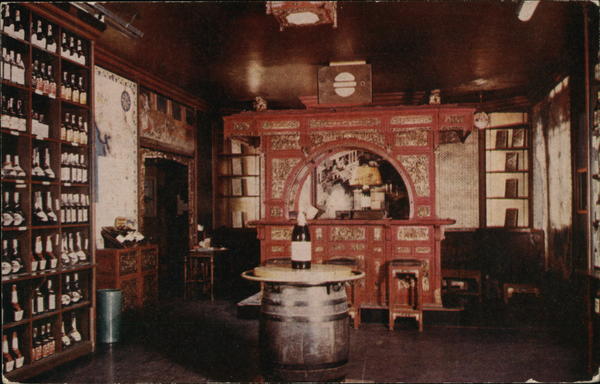
Front: BEL 4ミ Back: Verdier's cellars, Normandy Lane, where you will find the finest in wines and liquors. City WESTER DOUGLAS 4500 UNION SQUARE SAN MATEO. SAN FRANCISCO VALLEJO
- Previous Product
- Next Product
Post a public comment, question or review:
- Nos agences
- Voyages Groupes & entreprises
- A propos de VERDIÉ
- Liste Cadeaux
- Newsletters

Voyages en CROATIE
Un voyage en Croatie, c'est la découverte d'un petit paradis méditerranéen aux portes de l'Italie. Gardée par la mer Adriatique, la côte vous offre un patrimoine d'une rare diversité et de véritables joyaux architecturaux, fruits de multiples influences culturelles : l'amphithéâtre de Pula, le Palais Dioclétien à Split ou encore les remparts de Dubrovnik.
Visitez aussi des villes somptueuses telles que Zadar, Sibenik et Trogir. Entre les vues splendides du littoral, les balades romantiques sur les îles Elaphites ou encore la découverte du parc national des Lacs Plitvice, la richesse des paysages est sans limite. La faune est également très riche ! Avec un peu de chance, vous pourrez apercevoir des loups, des lynx ou des ours.... Quelle que soit la formule, votre séjour en Croatie vous laissera sans voix !
Voyages en petit groupe : circuits, itinéraires d'exploration, croisières
Voyages individuels : voyages itinérants, circuits privatifs, séjours, voyages sur mesure
... Envie d'un voyage entièrement sur mesure ?
La destination ou le voyage de vos rêves ne se trouve pas dans nos collections ? Décrivez en détail votre projet à l'aide de ce formulaire, nos conseillers vous contacteront pour en discuter
Consultez ou commandez nos brochures en ligne en cliquant sur ce lien.
Soyez au courant des dernières nouveautés, abonnez-vous à nos différentes thématiques en cliquant ici !
- Circuits accompagnés
- Version DÉCOUVERTE
- Version EXPLORATION
- Version CROISIÈRES
- Voyages individuels
- Version LIBERTÉ
- Groupes, Associations, CE
- Liste de mariage & cadeaux
- Chèques cadeaux
- Conférences
- Nos brochures
- Conditions Générales et Particulières de Vente
- Assurances et garanties
- Mentions légales
- Gestion des données personnelles
- Recrutement
- Qui sommes nous ?
- Séjours jeunes
- verdiehello.com
- verdieopenclass.com
- Services aux entreprises
- verdiebusiness.com

- The Argonaut
- Power and Money
- Architecture
- What Links Here
- Add an Article
- Edit Article
- Upload Media
The City of Paris
Historical Essay
by Nora Leishman

City of Paris with Union Square and I. Magnin’s.
Photo courtesy of Phillippe de Tessan.
In 1950, on the 100th anniversary of the City of Paris in San Francisco, company president Paul Verdier wrote a brief history of his family’s store.
When gold was discovered in California, Napoleon, who was the President of the French Republic, became Emperor of France.
A great many old Republicans resented having to obey a Dictator and many of them who had heard of the discovery of gold in California left France to try and make another fortune in this wonderful new Eldorado.
My grandfather, Felix, was one of them but, instead of coming with a pick and shovel, he brought in French wines and liqueurs for the men and laces and silks for their wives and sweethearts. We have original documents dated l851 listing baskets of champagne, casks of rare wines and barrels of brandy, showing that our great-grandfathers certainly were not prohibitionists, and other bills of l853 listing bonnets, Persian shawls, cotton and woolen stockings, petticoats, neck handkerchiefs, laces and silks, proving that our San Francisco ladies from the earliest day were very fashionable dressers.
My Grandfather, after sailing from France and crossing the Isthmus of Panama with mule packs, chartered a brig and entered the Golden Gate in the Spring of 1850. Floating from the masthead was a flag bearing the name of the “Ville de Paris” with its crest and motto, “Floats but never sinks,” and this is the name and inspiration with which the City of Paris has been endowed.
Felix Verdier, and his brother Emile, a prosperous French merchant who provided the merchandise aboard the Ville de Paris, had planned to open a store in San Francisco immediately, but the goods sold so rapidly from the ship that they had no choice but to sail back to France for more stock.
In 1851 the Ville de Paris store was officially opened on the southeast corner of Sutter and Kearny. In l860 it was moved into the Occidental Hotel, the most fashionable in the city, on the corner of Montgomery and Sutter. By 1890, Felix’s son Gaston had joined the then-forty-year-old firm and became its President. It was he who chose the final site of the Ville de Paris, at Geary and Grant on Union Square. He changed the name to City of Paris and added the motto from the original ship, “Fluctuat nec Mergitur.”
Gaston’s son Paul took over management in 1904 at the age of twenty-three. Two years later, after the earthquake and fire, he moved the merchandise into the beautiful Hobart mansion on Van Ness at Washington.
By 1907 the final City of Paris was rebuilt on the Geary and Stockton site. In 1918, Verdier added another block to the property on the corner of Stockton and O’Farrell. The store was designed by architects Arthur Brown and John Bakewell (designers of the War Memorial Opera House and the Veterans Building) with the aid of French architect Louis Bourgeois, all alumni of the Ecole des Beaux Arts of Paris.
The lacy grillwork of the City of Paris rotunda, in the style of Louis XVI, gave an open view to all floors. The circular interior was topped by a stained-glass dome depicting the Ville de Paris in full sail. The design created a space large enough to allow for a forty-foot Christmas tree each year, a tree that remained fresh and fragrant in the memory of San Franciscans long after the store was gone.
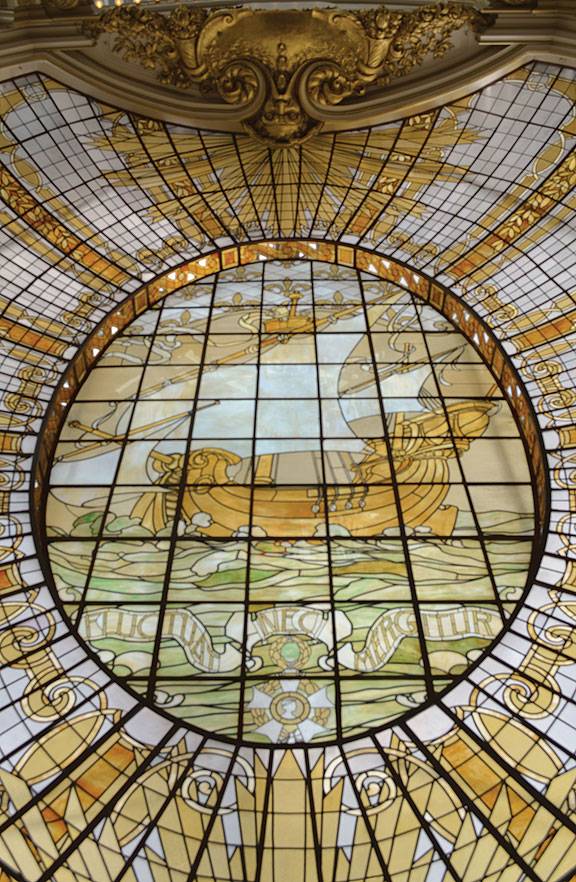
The original stained-glass dome in the City of Paris, still inside the new Neiman Marcus department store on the same location.
Photo: Art Peterson
Paul Verdier managed the store until shortly before his death at the age of eighty-four in 1966. He had joined the City of Paris staff in 1901, after graduating from the University of Paris at nineteen. He returned to France to fight in World War I, where he won two decorations, the Croix de Guerre and Knighthood in the Foreign Legion. He then came back to San Francisco as president of the store at twenty-three - a dashing, water skiing, tennis playing, polo player.
When France fell to the Nazis in 1940, Paul Verdier became a United States citizen and perhaps the most prominent leader of San Francisco’s French community. The French government promoted him to Commander, highest rank in the Legion of Honor. He served as Ambassador to the United States from Rumania and Monaco, was a Captain in the State National Guard, and President of the California Palace of the Legion of Honor.
Under his guidance branch stores were built in Vallejo, San Mateo, Northgate, and Stonestown, but it was the store on the corner of Geary and Stockton that the city remembered.
From the day that gold miners paddled out to the Ville de Paris to buy lacy underwear for their girlfriends, the City of Paris held a unique role in the lives of city shoppers. It was always a hometown store but with a brilliant design and a touch of elegance and savoir faire. Many San Franciscans fought to keep the building intact when the Verdiers no longer managed it.
Normandy Lane
One of the more unusual features of the City of Paris was a street-like department called Normandy Lane. It was unique and set the City of Paris apart from every store in the country. The Lane could have been a setting for “La Bohème” or a Simenon mystery. Its counters were mis-matched, the floors were uneven, and the awning on each booth drooped. But it was rich with the aromas of browning meats and baked breads, and it was an ideal spot for browsing and shopping, like so many small streets in France.
To get to the Lane you walked down a short flight of stairs on the O’Farrell Street side of the store. On your right was the French book store, with a tri-color kiosk for children’s books, and then a long stall full of French magazines and novels, dictionaries, and pièces de théâtre. Next came a cigarette and candy booth and then the bustling Normandy Lane tea room. The spécialité de la maison was Tripe à la mode de Caen, served with moist, spicy cinnamon rolls.
Back on the O’Farrell Street side, across from the bookstore, was a watch repair shop and a booth for the sale or exchange of rare stamps. Then came the Rôtisserie and the Pâtisserie. Before the days when a barbecue was standard home equipment, customers stopped to enjoy the sight of the chef, in his gros bonnet, tending to the plump chickens sizzling on the spit. Crusty croissants and sticky almond macaroons were the bakery specials. After World War II, with food rationing over, the department offered a picnic box for two, with a disjointed chicken, two salads, and two desserts for $2.25.
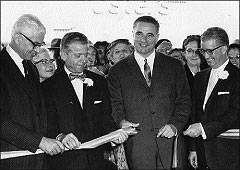
Opening of City of Paris in Stonestown. George de Bonis and Mayor George Christopher. (Others unidentified.)
Tucked away between the kitchen and the Verdier Cellars, Madame Kurtzweil, like Madame de Farge in Tale of Two Cities, sat in her straight-back chair and snipped away at precise, black paper silhouettes. She was proudest of her profile of actor Charles Boyer, but thousands of San Francisco children posed for her and servicemen sent their silhouettes back to their families.
At the end of Normandy Lane, with a stairway leading up to the Geary Street entrance, there was a small dark bar which stayed open until seven o’clock. It served as a romantic French rendezvous site for many young working couples.
Verdier Cellars
The biggest attraction in Normandy Lane was the Verdier Cellars, which opened on December 6, 1932, the day after Prohibition was repealed. It was one of the most famous cellars in the country and the Tchen-Tchen bar at the entryway was its trademark. Like most French people, the Verdiers had a passion for chinoiserie. The Tchen-Tchen bar was made from an enormous red lacquer bed which had been a family treasure.
Behind the Cellars, and known to a select few, was Verdier’s private dining room with its famous circular table. The chief French delegate to the United Nations and the playwright Luis Verneuil would dine there with George Duhamel of the Academie Française. Local politicians and opera stars were on the guest list, too.
The Cellars and all of Normandy Lane were authentically French, fashioned under the trained eye of Charles Gassion, who had been born in Caen, Normandy, the son of the city architect. Charles studied with his father and then in Paris until the beginning of the First World War. He joined the army as a sergeant: young Paul Verdier was his Captain. At Verdier’s invitation, Gassion came to America in 1932.
He arrived from Caen just in time to design the Verdier Cellars from the dusty, largely unused basement of the store. He worked for Verdier the rest of his life, married a Frenchwoman from the linen department, and became a guiding light in the French community until, many years later, he suffered a stroke while dining in Normandy Lane. When Caen, his home town, was destroyed in the Normandy Invasion, Gassion organized the “Free Caen” movement here, raised substantial amounts to restore the city, and was proud of the bronze medal that the French government awarded him. He organized a club for the French war brides who thought that they had been deceived about their husbands’ families and fortunes. He helped them find jobs to earn their passage home. He was not proud of his niece, singer Edith Piaf, but he did finally agree to meet her when she came to San Francisco. Gloria Duffy, a young saleswoman in Normandy Lane, remembered Piaf as “unkempt, her fingernails were terrible.”
Emile Drevoir, who later opened a big liquor store in the avenues, served as the first manager of the Verdier Cellars. Drevoir said of Verdier, “He was fantastic...his whole heart was in that project. He had wines nobody in the city had. He knew more about wines than anybody I ever knew.
“Verdier fought to prevent the possible reoccurrence of the ‘curse’ of Prohibition,” Drevoir added.
According to Verdier, the thirteen years of Prohibition had set back our wine industry for as many years, during which all other wine-producing countries had made vast improvements. Of 700 wineries in the region in 1920, only 150 were left in 1932. Verdier wrote an educational booklet about wines, explaining which wines came from various areas of France and the correct glass to use with each, but his primary goal was to stir interest in local production.
His booklet “California-America Vineyards” tells the story of the wine industry here. An early promoter of California wine, he was the first to buy from the young Souverain winery. The Verdiers bottled some varities under their own private label.
Verdier had five or six warehouses on the San Franciscco waterfront, crammed with the finest wines and liquors, and he opened the Cellars in 1933, a wholesale and a retail outlet. Just before World War II, when it became illegal to engage in both operations, Verdier retrenched to retail sales only. The Cellars had an extraordinary inventory with huge allotments from Schenleys and other wine and liquor suppliers.
A Verdier Cellar ad from 1942 would make you weep. A bottle of Château Latour Haut Brion, 1925, or of Château Smith-Haut-Lafitte, 1928, sold for $1.45 a bottle. Throughout the war, Normandy Lane was stocked with the best wines of France.
Late in the war, Verdier opened City of Paris branches in San Mateo and Vallejo. Emile Drevoir was put in charge of the Cellars in both stores and he was replaced in San Francisco by George Marie Victoire.
Like the designer of Normandy Lane, Charles Gassion, Victoire was a native of Caen. He came to America during the Second World War “to learn how to convert meters into inches and feet, so that I would know how many feet high I was flying.” Stationed at Lowery Air Force in Denver, he met a beautiful Colorado girl and promised to come back for her after the war. When he returned to San Francisco, he appealed to fellow-Caensmam Charles Gassion for work. Gassion put him up and found him a job at the City of Paris. “I was so shy,” Victoire remembers, “that they thought at the store that I couldn’t speak English. I wound up wrapping packages.”
Eventually he convinced Verdier of his talents and was rewarded with the management of the Cellars in 1946. Then he went back to Colorado to claim his bride, the late Judge Ollie Marie Victoire.
Victoire shared Verdier’s enthusiasm for California wines. The Cellars were changing their early emphasis on French wine and they were also attracting a post-war feminine clientele. Marie Victoire kept a supply of shoe boxes on hand to disguise bottles the women carried home.
It was the Count Poom de Ralguine who never allowed the cellar to lose its elegant panache. A close friend of Verdier’s, of Russian descent, Poom de Ralguine was an almost daily fixture at the Tchen-Tchen bar entrance, serving as welcoming host into his nineties, elegantly groomed, always with a carnation in his lapel.
THE Kiosk and the French Bookstore
The Kiosk and the Book Stall played a large role in Normandy Lane and in the city, during World War II.
Renee Leavy arrived in the Lane, like Gassion and Marie Victoire, courtesy of Paul Verdier. Renee was in San Francisco from France, visiting a cousin, when France collapsed in 1940. She had to get a job in order to stay and applied to the City of Paris personnel department. “Your accent is too bad. No one could understand you”, they told her.
She tip-toed down the hall to Paul Verdier’s office, left her number and he called her the next day.
“Do you have good looking legs?” he asked.
“I hup zow!”
“Good. Be in the Beauty Salon tomorrow morning.”
In the Salon, they painted Renee’s legs with Nina’s Stocking Film “to create sleek, sun-gold legs,” as the ads promised. Painting one’s legs was a big part of the war effort for thousands of women, because the only alternative was to wear baggy, rayon stockings. The stocking film sold well.
Ultimately Verdier decided to open a small kiosk from which to sell French books. He put Renee in charge and soon the red, white, and blue kiosk became as familiar a symbol as the Tchen-Tchen bar in Normandy Lane. Le Petit Prince, Babar en Famille, and Fou Fou Discovers America were best sellers there.
The author of Fou Fou, Jean de Boutin, was another French war refugee imported by Verdier. He was a known artist in his own country, but not here, when he arrived in the early 1940s. He moved into the Verdier home, where he wrote the children’s story Fou Fou Discovers America especially for Normandy Lane. In French, with an English translation, the book sold thousands of copies. It was the story of a plucky poodle, a caniche, and his adventures as he flew across America. In the end he died and parachuted down on a white morning glory into – where else? – Paris. Fou Fou silk scarves and records sold almost as well as the book.
Because of the success of Fou Fou, Verdier rewarded Renee with an enlarged shop. The kiosk was followed by a long book stall behind which de Boutin painted a Bord-de-la-Seine mural.
Throughout the war years, Renee entertained a long series of distinguished guests. Movie star Claudette Colbert ordered Larousse Gastronomique from Renee. Hollywood designer Helen Rose called often for help in designing French costumes. Charles Boyer and Rita Hayworth were regular customers. An album, recorded in French by Boyer, sold well at the shop. “Toujours les Memes”, it was named, “Always the Same.” Boyer told the whole sad history of the endless enmity between France and Germany, tracing back to the wars of 1870 and 1914. And servicemen ordered their Dictionary of French Conversation in the Lane bookstore, not realizing that they were getting ready for a trip to Normandy.
Verdier’s sister, the Countesse de Tessan, appeared in the shop each day. She had come to San Francisco, dressed in black, the widow of an underground hero executed by the Nazis. A good deal of charitable work was organized in Normandy Lane. Verdier himself organized a “France Forever” unit. For its benefit Normandy Lane offered handsome solid silver Croix de Lorraine and brilliant tri-color silk scarves.
Symphony conductor Pierre Monteux, his wife, and other French families donated valuables to be auctioned in the Lane for the benefit of the Free French. The most notable item was a set of glasses which had belonged to the Tsar.
Toward the end of the war, Jeanne Salinger, Director of the Office of French Information, organized the Food for France program for Verdier. With Normandy Lane’s Chef, Victor Faure, she shipped over 50,000 food packages. The City of Paris paid the shipping and sold the food at cost. Jeanne won the Order of Merit from her government for her efforts in the war. She was, incidentally, the mother of young Pierre Salinger, who became John F. Kennedy’s press secretary and, briefly, U.S. Senator for California. Salinger followed in his mother’s footsteps in the 1990s when he became involved in a project called “Wall of Liberty,” to build a memorial in Caen to all Americans who served in Europe.
The End of an Era
After the Second World War the City of Paris continued to do well, though other downtown stores disappeared one by one: O’Conner Moffitt, Ransohoffs, The White House... One man was largely responsible for the continued stability of the City of Paris during those late years. Italian-born George de Bonis had come to the store in 1914 as a stockboy. He served in many departments, and was elected to the Board of Directors in 1936. His natural talent in interior decorating and his expertise in fine furniture and antiques gave world-wide fame to the store’s home furnishings department.Verdier and de Bonis were good friends, traveling to Europe together and spending time at the Verdier Ranch, Vertes, in Sonoma, with family and often with employees from the store.
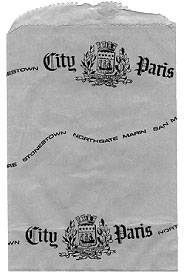
Bag from the City of Paris.
Courtesy of the author.
When Verdier died in 1966, de Bonis took over as President. When George de Bonis died in June of 1969, the Board of Supervisors adjourned their meeting in his honor.
Verdier’s sister Suzanne, the Countess de Tessan, became Administrator. In 1964 her two sons, Phillipe and Henri, arrived from Paris to help in the store, joining their cousin, Paul Chauvin, son of Verdier’s sister Marie, who had come earlier. The Verdier family remained deeply involved in the business until the day the City of Paris closed.
By 1972 merchandising everywhere was changing. With Paul Verdier and de Bonis gone, the City of Paris began to fail. The San Mateo, Vallejo, and Northgate branches closed. The Stonestown store became Liberty House, and half of the City of Paris’ downtown property in San Francisco was sold to Broadway Hale. The Texas firm of Neiman Marcus was anxious to buy the original store property, but only if it could tear down the old store.
Five years of bitter wrangling followed. The editor of Preservation News wrote, “In its race to the future, the city is destroying the very qualities that keep it so charming.” The National Trust for Historic Preservation opposed the demolition of the City of Paris building, and hundreds of loyal San Franciscans appeared before the Planning Commission to save it.
Lawyer Assemblyman Willie L. Brown, Jr. represented Neiman Marcus; and ultimately Nieman Marcus won, but only because the architect, world-renowned Philip Johnson, conceived a brilliant notion. Chronicle Architectural Editor Allan Temko noted that Johnson’s plan included “salvaging the exquisite sky-lit rotunda of the City of Paris. The lovely rococo plaster decoration of this wonderful space, together with the golden and colored glass of its elliptical dome” would be taken down and re-erected on a new steel frame.
Thanks to Philip Johnson, when you walk through the doors of Neiman Marcus on Geary and Stockton today, looking upward to the stained glass dome you will find the motto and inspiration for the old Ville de Paris, “Fluctuat nec Mergitur.” It floats but never sinks.
The Pony Express , May 1950 Souvenir brochure commemorating the City of Paris’ one hundredth anniversary History of Verdier Family translated from Guide franco-californian du Centenaire by Jeanne Bietry-Salinger. California Living , June 17, 1979, “Life on Normandy Lane”
Acknowledgements
I want to give special thanks to Phillippe de Tessan, son of the Countesse de Tessan and nephew of Paul Verdier, and to Florence Hauser, daughter of George de Bonis, for their personal recollections and photographs. George Marie de Victoire, a native of Caen, contributed his on-the-scene memories of Normandy Lane, Verdier Cellars, and the intimate connection between the City of Paris and war-torn Caen in France.
ABOUT THE AUTHOR
Nora Leishman is a freelance writer in San Francisco. Her article on the Mechanics’ Institute Fairs, 1857 to 1899, appeared in the Fall 1999 issue of The Argonaut .

IMAGES
VIDEO
COMMENTS
Découvrez nos voyages au Monténégro : circuit accompagné, séjour ou voyage individuel à la carte. Le Monténégro apparaît comme l'une des grandes découvertes touristiques de ces dernières années.
Ce tour du Monténégro vous laissera entrevoir la diversité des richesses qu'offre le plus petit pays des Balkans, entre mer et montagnes.
Escapade citadine. 5 jours / 4 nuits. Voiture de location incluse. Vols A/R compris. à partir de 895 €* *Exemple de prix/personne - au départ de Paris sur vol Transavia le 10/04/2024, en hôtel 3* avec petits déjeuners et la location de voiture de cat B - variable en fonction de la saison et de la disponibilité. Demander un devis.
The drive along the coast from Dubrovnik is a beautiful one (Credit: Ilya P)Through Croatia. It's still possible to reach Montenegro this way: buses run five times per day between Dubrovnik and Kotor, stopping in the border town of Herceg-Novi along the way. Schedules change at short notice, so ensure you double check close to departure.This happened to me on my first visit to Montenegro.
Site officiel de l'Office National du Tourisme du Monténégro. Les informations pratiques et les conseils que nous vous donnons vous permettront de mieux vous organiser, de préparer votre séjour, de prévoir votre itinéraire et de réserver en temps et en heure.
Discover the ultimate Montenegro itinerary for your first visit! Visit Kotor, Perast, Budva, Mount Lovcen, Durmitor and more in 7 days!
Avec ce circuit Croatie - Monténégro sur mesure, passez 10 jours à flâner dans les ruelles des belles citadelles de l'Adriatique. Un voyage culturel et ensoleillé.
Départ Paris. Le 28/09/2024. Avion + Circuit8J/7N en pension complèteDécouvrir «la perle cachée de la Méditerranée» : le Montenegro, union parfaite de la mer et de la montagne, et sa voisine croate, «la perle de l'Adriatique» : Dubrovnik tout en restant dans le même hôtel pour profiter de quelques jours de détente en club.
Créez votre voyage sur mesure en direct avec notre agence de voyage au Monténégro, ou rejoignez un circuit en petit groupe. Trekking, séjour culturel et vacances en famille au Monténégro.
Circuits au Montenegro avec votre agence locale Luminalis. Privatiser ou personnaliser un de nos séjour pour une découverte en couple, en famille ou entre amis du Montenegro.
Your complete guide to Montenegro travel, from the Bay of Kotor to Durmitor National Park and beyond. A must-read before you travel to Montenegro!
Autant d'élans voyageurs que VERDIÉ VOYAGES vous inspire depuis sa création, en 1985. verdie-voyages.com and 3 more links Vérone, patrimoine & musique 2,014 views Streamed 4 months ago
Spécialiste du voyage : circuits accompagnés, voyages culturels avec guides-conférenciers, voyages individuels à la carte, croisières, autotours, séjours. Découvrez notre offre de voyages pour satisfaire toutes vos envies d'évasions.
Un Autre Voyage au Monténégro pour la destination du mois ! Frédérique crée pour vous votre circuit sur mesure et un voyage personnalisé. Voyage personnalisé. Circuit sur mesure. Agence de voyage à domicile. Un Autre Voyage. Voyage sans intermédiaire.
On Montenegrovoyage you can find travel informations, daily excursions, Montenegro info, real estates, hotel accomodations, and if you are planing to visit Montenegro you're in the right place.
VERDIER VOYAGE (@verdier.voyage) sur TikTok |135 j'aime.35 followers.VERDIER VOYAGE Agence de tourisme et voyage Jijel ( bab sour )Regarde la dernière vidéo de VERDIER VOYAGE (@verdier.voyage).
The first of this year's Solaire Journeys rolled from Singapore to Kuala Lumpur via the Eastern & Oriental Express, while the year's final voyage—from Cusco, Peru, to Arequipa and Machu ...
Ce circuit permet une découverte optimale, de la Toscane croate à la perle de l'Adriatique.
The City of Paris maintained a connection with French culture reflected in the store's décor and merchandise. The Verdier Cellars stocked many fine French vintages and was the most extensive wine department of any American department store.
Verdier's Cellers, Normandy Lane. Verdier's Cellers, Normandy Lane. Sold. Stock #: 653392: Type: Postcard: Era: Chrome: City: San Francisco: State: California (CA) County: San Francisco: Size: 3.5" x 5.5" (9 x 14 cm) Additional Details: Where you will find the finest in wines and liquors. City of Paris Dry Goods Store - San Francisco-San Mateo ...
This video documents my 1,600 miles of travels from Phoenix, Arizona to the Bay Area in California for the March 24, 2018 show at Sonoma Raceway called "Radw...
Découvrez nos voyages en Croatie : circuit accompagné, séjour ou voyage individuel à la carte. Partez à la découverte d'un petit paradis méditerranéen aux portes de l'Italie.
In 1950, on the 100th anniversary of the City of Paris in San Francisco, company president Paul Verdier wrote a brief history of his family's store.